|
PART THREE
EXPLORING THE GREATER ANTIQUITY OF CIVILIZATION
10 - The Enigma of India's Origins
The Dating of New Discoveries in the Gulf of Cambay
Upsets the
Orthodox Scenario for the Dawn of Civilization
David Lewis
With three quarters of the planet covered by water, it's been said
we know more about the surface of
Venus than about that which lies beneath the sea.
Yet this may be
changing. The discovery of what may be a lost city off the coast of
western Cuba startled the archeological world in the spring of 2001.
Reports from Havana spoke of massive stone blocks stacked at a depth
of 2,100 feet in perpendicular and circular formations, some
resembling pyramids.
Researchers in a miniature submarine described
the area as an urban development, with structures that may once have
been roads and bridges.
Because a prediluvian "lost city" does not fit into the accepted
paradigm of prehistory, the halls of orthodoxy remain silent on the
matter - at least for now. And while those halls still stand, other
recent discoveries have begun to seriously erode their foundations.
Finding the ruins of an ancient, submerged civilization raises more
questions than it answers and causes more problems than it solves.
-
How did the land and its structures sink?
-
What could have prompted
such a large-scale cataclysm?
-
When did civilization on Earth
actually begin?
-
What do we really know about the ancient past and
human origins?
-
And how does the establishment of science, so fixed
in its doctrines, grapple with the potential demise of its most
cherished presumptions?
If the lost city of the Caribbean wasn't enough, about the same time
an equally startling discovery occurred twenty-five miles off the
coast of Gujurat, India.
The discovery took place in that part of
the Arabian Sea known as the Gulf of Cambay. India's National
Institute of Ocean Technology (NIOT) turned up some amazing sonar
images from the gulf's depths while scanning for pollution levels.
Using equipment that penetrates the sea floor, marine experts
discovered a pattern of distinct, man-made formations across a
five-mile stretch of seabed.
According to reports published worldwide, NIOT's sonar-imaging
technology detected what appeared to be the stone pillars and
collapsed walls of at least two cities. The site was described as
part of an ancient river valley civilization not unlike the River
Saraswati of the Rig Veda, thought to be mythical but - according to
recent independent findings by Indian scientists - has been proved
to have flowed to Gujurat.
Divers at the Gulf of Cambay site later
retrieved from depths of 120 feet two thousand man-made artifacts,
including pottery, jewelry, sculpture, human bones, and evidence of
writing, according to The Times of London.
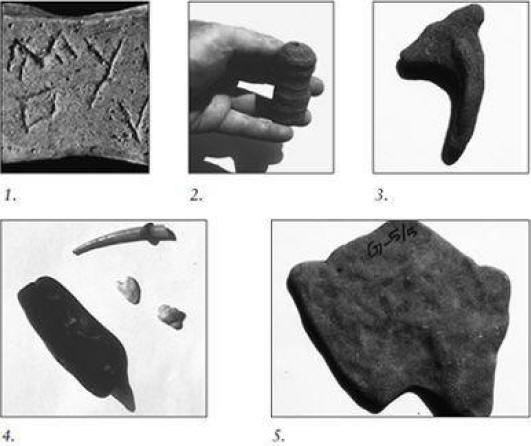
-
Inscribed pottery from the Gulf of Cambay.
-
Artifact from the Gulf of Cambay. Small asymmetrical cylindrical
object with hollowed middle. (PHOTOGRAPH BY SANTHA FAIIA)
-
Artifact from the Gulf of Cambay. Possible carving of a deer or
other animal appears symmetrically on both sides of object.
(PHOTOGRAPH BY SANTHA FAIIA)
-
Group of four objects from the Gulf of Cambay. (PHOTOGRAPH BY SANTHA FAIIA)
-
Artifact from the Gulf of Cambay. Stone slab suggested by NIOT to
be engraved with archaic script or other deliberate marking or
symbols. (PHOTOGRAPH BY SANTHA FAIIA)
"Underwater structures that have been found along the Gulf of
Cambay, Gujarat, indicate an ancient township that could date back
anywhere before or during the Harappan civilization," Science and
Technology Minister Murli Manohar Joshi told the world at a press
conference in May 2001.
Murli Manohar Joshi's initial guess was that the five-mile-long site was four
thousand to six thousand years old and had been submerged by an
extremely powerful earthquake.
But in January 2002, carbon dating
revealed that an artifact from the site was astonishingly ancient,
between 8,500 and 9,500 years old (the oldest known civilization in
the world by thousands of years). This was a time when, according to
orthodox archeological standards, India should have been peopled
with primitive hunter-gatherers and a few settlements, not the
inhabitants of a lost civilization.
The author and underwater researcher Graham Hancock described
buildings at the site as being hundreds of feet in length. with
drains running along the streets.
"If the case is made [for the age
of the underwater cities]. then it means that the foundations are
out of the bottom of archeology." Hancock said.
The scope and sophistication of the site dismantles the specific
belief that civilization began five thousand years ago in Sumeria,
according to Hancock, even as the alternative scholarship movement,
of which he is a central figure, in general challenges orthodox
views about human origins.
In the orthodox (Darwinist) view, life,
and then human beings, emerged extremely slowly from highly
improbable accidental causes over a period of time necessitated by
laws of probability.
The theoretical four-billion-year age of the planet was determined
not by scientific or geologic evidence, according to the science
writer Richard Milton (author of Facts of Life: Shattering the Myth
of Darwinism), but by estimating how long it should have taken for
accidental life to have occurred. given the extreme improbability of
life having occurred at all through random, material causes.
Civilization followed, according to the scenario, after the
theoretical "out-of-Africa" migration (about 100.000 years ago),
fairly recently in prehistory. Evidence of extremely ancient
civilizations, or of severe cataclysmic disruptions (those
resembling mythical events that may have shaped the ancient world),
throws a wrench into the conventional machinery.
Discoveries that
reveal civilizations having existed several thousand years earlier
than previously thought are greeted with disbelief, consternation,
silence. Evidence, then, of modern man having lived, say, 250.000
years ago in South America is considered preposterous and heretical,
although the evidence for it exists.
Other views, modern and ancient, portray life as having emerged by
more mysterious means, not by a series of astronomically improbable
accidents, not through a biblical creationist scenario, but by
virtue of some other unknown agency.
This other, unknown agency, an
all-pervasive life force more in keeping with
The Tao of Physics
than
Origin of Species, is such as that evidenced in Eastern healing
disciplines and codified impressionistically in the world's
mythologies.
In this latter view. the idea that prehistoric civilizations existed
needs not be rejected due to a presumption that life evolved from
material causes alone over an arbitrary time line necessitated by
improbability. Tradition in India has always held. in fact. that
Indian culture predates all understanding. being virtually timeless.
stretching into the mists of antiquity from whence sprang the gods
and myth - the non-space/non-time reality of modern theoretical
physics.
As we shall see. certain mythical traditions maintain that the
landmass of ancient India greatly exceeded its present size. and
even that it stretched from Australia to Madagascar. perhaps as an
archipelago. As with the archeological discovery of Troy. once
thought to be a myth. it must be recognized that at least some of
India's supposedly mythical traditions are rooted in historical
fact.
This leads to the idea of an "Asian Atlantis," which may seem
fantastic. but early geologists believed such a continent existed.
The notion may again be gaining credence after the discoveries in
the Gulf of Cambay and given NIOT's intention to investigate other
submerged archeological sites off Mahabalipuram and Poompuhar in
Tamil Nadu.
Current conceptions of Western scholars conflict with traditional
Indian beliefs about such things. but that wasn't always the case.
In the mid to late nineteenth century. when scientific ideas about
human
origins had begun to take shape in Europe. early geologists and
archeologists accepted the idea of a biblical flood. lost continents
(for which they found much evidence), and a landmass in the Indian
Ocean - the great Southern Continent of the British naturalist
Alfred Russell Wallace.
Even today, mainstream science believes such landmasses as
Gondwanaland and Pangaea existed, although they are relegated to the
extremely ancient epochs of 180 to 200 million years ago, in keeping
with beliefs about the age of the planet necessitated by an
admittedly improbable evolutionary process.
And consider the South
Asian traditions that mimic the findings of the early geologists,
those who say an inhabited continent existed across what are now the
Indian Ocean, the Arabian Sea, and the Bay of Bengal.
These
traditions live to this day in the lore of southern India, Sri
Lanka, and the islands of the Andaman Sea.
"In a former age," an ancient Sri Lankan text states, "the citadel
of Rawana (Lord of Lanka), 25 palaces and 400.000 streets were
swallowed by the sea."
The submerged landmass. according to one ancient account, rested
between Tuticoreen on the southwest Indian coast and Manaar in Sri
Lanka.
This submerged landmass was not a landmass of the size
envisioned by the early geologists, but - if it actually existed - a
submerged portion of the Indian subcontinent just the same.
Another cultural tradition, cited in Allan and Delair's Cataclysm!
Compelling Evidence of a Cosmic Catastrophe in 9500B.C., that of the Selungs of the Mergui Archipelago off southern Burma, also speaks of
a sunken landmass:
"...formerly [the] country was of continental
dimensions, but the daughter of an evil spirit threw many rocks into
the sea... the waters rose and swallowed up the land...
Everything alive perished, except what was able to save itself on
one island that remained above the waters."
One of the Tamil epics of southern India, the Silappadhikaram,
frequently mentions a vast tract of land called Kumara Nadu, also
known as Kumari Kandam, stretching far beyond India's present-day
coasts.
Ancient south Indian commentators wrote in detail of a
prehistoric "Tamil Sangham," a spiritual academy situated in that
ancient land. They wrote also of the submersion of two rivers, the Kumari and the Pahroli, in the middle of the continent, and of a
country dotted with mountain ranges, animals, vegetation, and
forty-nine provinces.
This Pandya kingdom, according to tradition,
reigned from 30.000 B.C.E. to 16.500 B.C.E. At least one branch of
modern-day south Indian mystics claims a direct lineage from those
extraordinarily ancient times, when their spiritual progenitors were
said to have achieved extremely long lives through yogic techniques.
And India's epic poem the Mahabharata, dated by non-Westernized
Indian scholars to five thousand years before Christ, contains
references to its hero, Rama, gazing from India's present-day west
coast into a vast landmass now occupied by the Arabian Sea, an
account supported by the recent underwater discoveries.
Less
celebrated Indian texts even mention advanced technology, in the
form of aircraft used to transport the society's elite and wage war.
The
writings describe these aircraft in detail and at great length,
puzzling scholars and historians. The great Indian epics, what's
more. vividly describe militaristic devastation that can be equated
only with nuclear war.
Was there, at one time, not just an ancient
civilization in India, but an advanced ancient civilization?
Flying machines... lost continents... are these mythical tales
of mythical lands or do these ancient references provide us with a
historical record long forgotten and then dismissed by Western
science as fantasy?
To answer that question, we must look at the history of scholarship
as it pertains to India. Since the nineteenth century, Western
scholars have dismissed the historical significance of the cultural
traditions of ancient peoples, those of southern Asia included. With
a decidedly ethnocentric bias, the experts reinterpreted history as
it was taught in the East.
Having found, for example, that root
words of India's ancient Sanskrit turn up almost universally in the
world's major languages, Western scholars devised an ethnocentric
scheme to explain the phenomenon - one that modern Indian
intellectuals have come to accept.
A previous European people must have once existed, the scholars
imagined - an Indo-European race upon which the world, including
India, drew for its linguistic roots and genetic stock. The scholars
also expropriated the Aryans of ancient India to flesh out this
scenario.
This Aryan race, they told us, derived from Europe and
then invaded the Indus Valley in the north of India - making
Sanskrit and Vedic culture relatively young and a product, rather
than a progenitor, of Western civilization.
The "Aryan invasion" theory has since fallen into disrepute.
James
Schaffer, of Case Western University, a noted archeologist
specializing in ancient India, had this to say on the matter.
"The
archeological record and ancient oral and literate traditions of
south Asia are now converging."
In other words, India's mythology is being proved
historically
accurate.
Schaffer then wrote,
"A few scholars have proposed that
there is nothing in the 'literature' firmly placing the Indo-Aryans
outside of south Asia, and now the archeological record is
confirming this...
We reject most strongly the simplistic
historical interpretations [of Western scholars], which date back to
the eighteenth century... These still prevailing interpretations
are significantly diminished by European ethnocentrism, colonialism,
racism..."
Southern India, a land whose cultural roots are said by some to
stretch into an even more profound antiquity than do those of the
north, suffered a similar fate.
Speakers of a proto-Dravidian
language, the forerunner of a family of languages spoken in the souths - and some say of Sanskrit itself - entered India from the
northwest, the Western scholars insist.
Both invasion theories were
necessitated by Western beliefs, at first about the Garden of Eden
theory of origins and then, with the arrival of the Darwinists,
beliefs about the widely held out-of-Africa theory.
But the Aryan invasion theory has been debunked. No skeletal
evidence shows any difference between the supposed invaders and the
indigenous peoples of India.
And satellite imagery now shows that
the ancient Harrapan civilization of the Indus Valley, and
Mohenjo-Daro, probably declined and disappeared due to climatic
changes, the drying up of the mythical Saraswati River, rather than
to the descent of imaginary invaders. The demise of the Aryan
invasion theory, though, and the recently discovered underwater
ruins open a Pandora's box for orthodox scholars regarding the past
- not just India's past, but that of the human race.
If Sanskrit
predates the world's other languages, and if ancient civilizations
existed where there are now seas, how can prehistory be explained in
modern Western terms?
And how much of the actual history of India is still obscured by
ethnocentricism, colonialism, or scientific materialism? The demise
of the Aryan invasion theory may represent only the tip of the
iceberg of misconceptions about the age and nature of ancient India,
her culture, her people, and her accomplishments.
It has long been claimed that Mother India was born in a time before
all myth began, when rishis, men of great wisdom and phenomenal
spiritual attainment, walked on Earth. This ancient India dates to
the times out of which the epic poems the Ramayana, the Mahabharata,
and the ancient traditions of Tamil Nadu in the south grew.
The
Tamil Nadu was a land whose culture is said by some to predate that
of the north. having once existed as part of Kumari Kandam and
dating to a staggering 30.000 B.C.E.
A great deluge inundated Kumari Kandam, obscure texts of the
Siddhartha tradition of Tamil Nadu reportedly say.
This is a notion
echoed in the writings of Colonel
James Churchward and W.S. Cerve,
both of whom claim knowledge of texts, Indian and Tibetan,
respectively, that speak of a long-lost continent situated in the
East.
While continental drift theory presumes the extremely slow and
uniform movement of landmasses over many hundreds of millions of
years. a great deal of evidence exists that Earth's surface changed
rapidly and violently in recent prehistory. A great sudden
extinction of mammals and plants took place on the planet around the
end of the last ice age. perhaps as recently as 12.000 years ago.
Hundreds of mammal and plant species disappeared from the face of
the earth, many of the carcasses having been driven by flooding into
deep caverns and charred piles the world over. Modern science has
been unable to adequately explain this event. and unwilling to
consider what seems obvious, based on the evidence.
D.S. Allan and J.B. Delair, in
Cataclysm! Compelling Evidence of a
Cosmic Catastrophe in 9500 B.C., amass a formidable quantity of
known evidence corroborating the flood/conflagration legends stored
in the world's mythological record.
If we suspend belief in the
textbook accounts of prehistory. Allan and Delair fill the void in a
convincing way. replacing gradualist doctrines that involve
extremely slow glacial movements (which are supposed to have
accounted for the great extinction) with what seems to have been.
upon a review of the evidence. a worldwide. phenomenal disaster that
submerged landmasses and ruptured Earth's crust.
Much of the evidence centers on southern Asia. Records gathered by
the Swedish survey ship Albatross in 1947 reveal a vast plateau of
hardened lava for at least several hundred miles southeast of Sri
Lanka. The lava. evidence of a severe rupture in Earth's crust.
fills most of the now submerged valleys that once existed there.
The
immense eruption that gave off the lava may have coincided with the
downfall of Wallace's Southern Continent (aka Kumari Kandam). for
which much zoological and botanical evidence exists that would give
such a landmass a recent date. according to Allan and Delair. not
the 180 million years that orthodoxy ascribes to such a continent.
The lost cities of the Gulf of Cambay may have suffered a similar
fate. at the same time or as a result of unstable tectonic
conditions resulting from the initial disturbance - an asteroid.
perhaps. or a displacement of Earth's crust - that caused the recent
extinction and destruction of the ancient cities.
Among the troves of evidence compiled by early geologists and
resurrected by Allan and Delair are
Asian bone caves filled with diverse species of recent prehistoric
animals from around the world.
These carcasses could have been
driven to their final resting places only by vast amounts of water
moving across the globe. In light of Allan and Delair's work. other
evidence such as India's Deccan trap, a vast triangular plain of
lava several thousand feet thick covering 250.000 square miles, and
the Indo-Gangetic trough. a gigantic crack in Earth's surface
stretching from Sumatra through India to the Persian Gulf, can be
interpreted as evidence of a cataclysm that ruptured Earth's crust.
submerged various landmasses, and caused the great extinction.
Other titillating fragments of anomalous evidence suggest a
pervasive if not advanced seafaring or even airborne culture having
once existed in ancient India - for example. the identical nature of
the Indus Valley script to that found at Easter Island on the other
side of the Pacific Ocean.
Initial reports suggest. it should be
noted. that the script found recently in the Gulf of Cambay
resembles the Indus Valley script.
According to certain south Indian
researchers. the indecipherable scripts are written in a proto-Tamil
language. which would link the culture of distant Easter Island and
its famous megalithic statues with ancient southern India, Kumari
Kandam - an idea echoed in the lore of Easter Islanders about a lost
continent to the West from which their people originated.
With the recent advent of underwater archeology. records of the past
are being rewritten. More research is needed. as well as more
expeditions into treacherous waters and the depths of the world's
oceans; but more than ever. textbook scenarios of prehistory are
drowning of their own weight while scenes of a more glorious past
rise to the surface via acoustic imaging.
Past being prologue, those
images are of interest not to academics alone, but to all who would
solve the mystery of human origins.
11 - Pushing Back the Portals of Civilization
For John Anthony West, the Quest for Evidence of Advanced
Prehistoric Civilization Is Bearing New Fruit.
J. Douglas Kenyon
Just as an athlete's ego is bound up in winning and he feels
miserable at losing the "Super Bowl,"
chuckles John Anthony West,
"the egos of scholars and scientists are
tied up in being right. They don't have much money and much fame and
there's no glamour in it, and when someone comes along, like me,
from out of left field they react like scalded cats."
Tormenting the reigning breed of cats remains a favorite source of
amusement to this self-appointed scourge of the "Church of
Progress."
For West, the modern Western version of civilization,
with "its hydrogen bombs and striped toothpaste," is no match for
its long-buried predecessors (both historic and otherwise), and
scholars who disrespect the legacy of our ancient forebears West
considers to be, at the very least, "idiotic."
When the saga of Atlantis Rising magazine began in November 1994,
our cover story, "Getting
Answers from The Sphinx," featured the
brewing storm surrounding research by West and the Boston University
geologist Robert M. Schoch, Ph.D., indicating that
the Sphinx of
Giza was rain-weathered and thus thousands of years older than had
been maintained by the Egyptological establishment. The controversy
has hardly subsided.
Since that time, the writers Graham Hancock and Robert Bauval have
joined the fray with enormous internationally best-selling books
underscoring West's contentions and adding their own concerning the
astronomical purposes of the Giza monuments.
And while all four
remain persona non grata among most professional Egyptologists,
their ideas - publicized worldwide in numerous media accounts - have
achieved an unprecedented notoriety and forced the establishment to
break from its standard practice of simply ignoring impudent notions
and actually, on occasion. to argue the merits of them.
The result has not been particularly encouraging to the Church of
Progress.
The September 16, 2002 Fox TV/National
Geographic special entitled "Opening the Lost Tombs: Live from
Egypt" aired live from Giza in prime time was but the latest of many
broadcasts to give major time to the heretical views of West, Schoch, Hancock, and Bauval.
Despite all efforts of the debunkers, support for their
notions continues to snowball.
At the heart of the controversy are the mysteries surrounding the
birth of civilization.
-
Did we, as the academic establishment
insists, emerge from the Stone Age about five thousand years ago and
only then begin the slow and painful ascent to our present "lofty"
heights?
-
Or was there, in remotest antiquity, a fountainhead of
civilization that rose to levels of sophistication equal if not
superior to our own, and yet which vanished so completely that
hardly a trace of it remains?
If the latter is true and can be proved, the implications are
profound indeed, if not earthshaking.
That West and Schoch may be
producing the first scientifically irrefutable evidence for the
existence of that progenitor culture could be one of the most
important scholarly achievements of our time, and one that could
rain convincingly on the parade of the Church of Progress.
Atlantis Rising talked with John West about his ongoing struggle
with the establishment and new evidence he has accumulated to
buttress and perhaps clinch his case for the existence of a
sophisticated prehistoric civilization.
He also talked about his
debt to an obscure Alsatian archeologist whose contribution to our
understanding of ancient Egypt is only beginning to be appreciated.
THE LEGACY OF SCHWALLER DE LUBICZ
The master plan to understanding the wisdom of ancient Egypt is
already in place, West believes, but does not, as you might expect,
come from within the precincts of the Egyptological establishment.
The massive work of R.A. Schwaller de Lubicz, assembled during an
exhaustive study of the Temple at Luxor from 1937 to 1952, amounts
to nothing less than "a unified field theory" of the philosophy and
science of ancient Egypt. Schwaller de Lubicz is best known for his
comprehensive, seminal work on ancient Egypt entitled The Temple of
Man.
He founded the "symbolist" school of Egyptology, of which West
is currently the most outspoken proponent. West's book,
Serpent In The Sky, remains the most complete commentary in English on Schwaller de Lubicz's work.
Schwaller de Lubicz was looking for evidence of ancient insight into
the principles of harmony and proportion. In particular he was
looking for knowledge of the Golden Section (a ratio mathematically
expressed as 1 plus the square root of 5 over 2), which has been
credited to the Greeks but not the Egyptians.
Using measurements
that were then in the process of determination by a French team of
architects and archeologists, Schwaller de Lubicz was able to
demonstrate that, indeed, the Golden
Section was applied at Luxor and with a complexity and
sophistication never achieved by the Greeks.
Here was irrefutable evidence of advanced mathematical development
existing more than a thousand years before Pythagoras.
"Obviously this didn't spring out of nowhere," says West.
"New Kingdom Egypt
(Luxor was built by Amenhotep III in the fourteenth century B.C.E.)
is in the tradition of Middle and Old Kingdom Egypt, so by
extension, Schwaller de Lubicz pretty much proved that Egypt
understood harmony and proportion from the reputed very beginnings
of its existence, back to 3000 B.C.E. or a bit earlier."
All of
which suggests the likelihood of still older developments,
coinciding nicely with the theories of West and Schoch about the age
of the Sphinx, which, interestingly, were based upon a casual
observation by Schwaller de Lubicz that the Sphinx had been
weathered by water.
"Egypt was in n o way a kind of magnificent dry run for Greece,
which in turn gave rise to our brilliant civilization," says West.
"The Greeks themselves acknowledged the greater fount and source of
the wisdom that came later.
In other words, civilization has been on
a downhill slide since ancient Egypt. In fact, ancient Egypt itself
was on a downhill trip from its very beginnings because, strangely
enough, it reached its absolute peak - the height of its prowess and
sophistication - fairly early in the Old Kingdom around 2500 B.C.E... and pretty much everything thereafter was a lesser
accomplishment, even the fabulous temples of the New Kingdom."
"But,... " the question has always persisted, "if there was an
advanced civilization in prehistory, where are the artifacts?"
That
is a question that John West has long sought to answer, and with the
discoveries at the Sphinx he has made a significant first step.
But the undeniable physical remains of that mother culture, he
insists, are in no way limited to the Sphinx. Several sites,
potentially as compelling, provide evidence that thousands of years
before the oldest acknowledged remnants of the so-called Old
Kingdom, Egypt was host to a highly developed civilization.
One
previously unnoticed site West now believes might well make his
case.
SECRETS OF THE RED PYRAMID
Usually attributed to the fourth-dynasty pharaoh Snefru, the Red
Pyramid of Dahshur is part of a military reservation and was until
recently closed to the public.
A near equal in total volume to the
Great Pyramid (credited to Snefru's son Cheops), the Red Pyramid (so
named for its pink granite) slopes a bit more gently. Fairly
accessible now, it offers visitors the opportunity to climb a steep
staircase on the northern face and then descend the 138 steps of a
long, sloping corridor to the first of two high-gabled chambers
that, though horizontal, resemble the grand gallery of the Great
Pyramid.
At the end of the second chamber are wooden steps, provided by the
Egyptian antiquities department, leading to still a third gabled
chamber, which, rising to a height of fifty feet, is at right angles
to the first two.
Standing on a wooden balcony, the visitor is able
to look down into a kind a pit surrounded by a jumble of worked
stones. No sign of a burial of any kind has ever been found in the
Red Pyramid.
When this writer first looked at that place, several points seemed
obvious. The stones in the pit were clearly of a different type from
those of the structure above. Moreover, while the pyramid had been
built with great precision, the arrangement of the pit was chaotic.
And even though the stones were doubtless cut artificially, their
edges had been rounded in a way that suggested water weathering. I
remarked to West that I thought the place must be part of a much
older site, over which the Red Pyramid had been
built. possibly to memorialize a sacred spot. Whatever weathering
had occurred clearly had been brought to a halt by the sheltering
pyramid. In making these observations.
I thought I was doing no more
than stating the obvious. but to my amazement. John West became very
excited.
"I think you're absolutely right." he exclaimed. "I don't
see any other possible explanation."
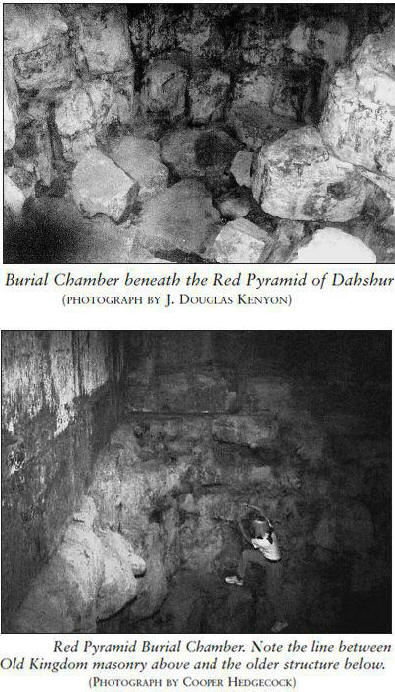
As it turned out, this was not the first time he had wondered about
the meaning of that chamber.
"I'd been into that Red Pyramid half
a dozen times since it reopened a couple of years ago." he
recalled. "puzzling over this strange. so-called burial chamber.
which didn't look as though it had been plundered."
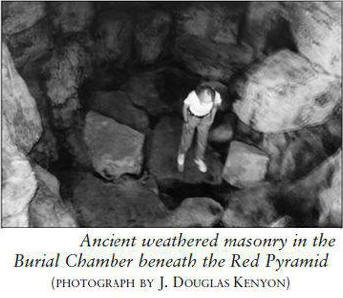
John West continues.
"Why is it in that state of disarray? It looks
as though it's been taken apart. but then it doesn't look as though
it's been taken apart. Not once did it occur to me that. hey. this
was once outside - not inside. Yes. these are old. deeply weathered
stones. The trick now is to get the geologists over there and see
just what kind of stones they are."
The experts, like Schoch, West believes, will also find ways of
dating the place.
Currently West is of the opinion that the stones
are hard limestone. and very old indeed.
"I think it was a sacred
spot to the very ancient Egyptians." he said. "and they built the
whole Red Pyramid around it."
Throughout the rest of our tour. West referred again and again to
what he said he felt was a "truly important discovery," even dubbing
the chamber Kenyon's Cavern, and adding that he felt the place might
serve. as nothing had yet, to "clinch" his case.
"The opposition is always saying," complains West, "how can the
Sphinx be the only evidence of this earlier civilization? Well. it
isn't. But then they go selectively deaf when I start pointing out
the other pieces of evidence."
Before the discovery in the Red
Pyramid, he looked at the Mastaba Fields. southwest of the Sphinx,
where a structure once served as the tomb of Khentkaus, the queen of Menkaure - the builder, it is said, of the third and smallest
Giza pyramid.
The ruined southwest corner of the structure reveals
that the 4.500-year-old repair covers blocks that are obviously much
older and which bear the same telltale signs of water weathering
that caused all the furor at the nearby Sphinx.
And there are other anomalies,
"The two-stage construction of the Khafre pyramid (the Greek historian Herodotus is our only source for
the attribution) - the giant blocks on the bottom and on the paving,
the slabs around the base - are absolutely out of sync with the
other Old Kingdom masonry that constitutes that pyramid.
The same
applies to the Menkaure pyramid. And there's the deeply weathered
shaft east of the midpoint of the Saqqara pyramid."
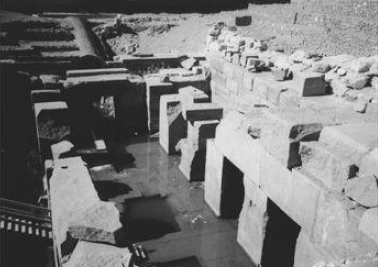
The Osirion at Abydos
(PHOTOGRAPH BY J. DOUGLAS KEN~YON)
He also sees strange inconsistencies between the valley temple near
the Sphinx and other constructions supposedly by Chephren.
Moreover,
West believes that the so-called Osirion at Abydos, with its massive
undecorated granite blocks, is certainly much older and of a style
completely alien to the neighboring temple of Osiris built by Seti I
in the New Kingdom:
"To attribute these two temples to the same
builder is like saying the builders of the Chartres cathedral also
built the Empire State Building."
West is hopeful that the many feet
of Nile silt strata that once covered the Oseirion, and which still
surround it, will eventually be carbon-dated and that this will put
the matter to rest.
West's evidence is not confined to architecture. In the Cairo
Museum. for instance. is a small vase associated with the dawn of
the Old Kingdom. Made from the hardest of diorite. the precision of
its form and its perfectly hollowed interior are impossible to
explain in terms of any known tooling techniques of the time. It
could be much older. as could many similar vases that have been
discovered.
And. of course. there are the pyramid texts carved into the walls of
fifth and sixth dynasty pyramids. The consensus among experts is
that the texts were copied from much older sources. Just how much
older is the question. On that same trip to Egypt. West was
accompanied by Clesson H. Harvey. a physicist and linguist who has
spent the better part of forty years translating the pyramid texts.
The texts, Harvey believes, reveal that the Egyptian religion
originates not millennia. but rather tens of millennia before the
Old Kingdom. West thinks Harvey is on the right track.
Despite the weight of the evidence. though. West is not expecting
established Egyptology to give ground quickly.
"It's very similar to
the Church of the Middle Ages and its rejection of Galileo's
heliocentric solar system. The centrality of humanity in God's
scheme wasn't something they were prepared to give up easily...
Now, the idea of a much more ancient source of civilization is a
very hard thing for Egyptologists to acknowledge. And it's not just
that civilization is older - but that it was sophisticated and
capable of producing technological feats that we can't reproduce."
TOWARD A PROPER EGYPTOLOGY
When it comes to proposing a suitable course for Egyptology.
West is
not ungenerous with his advice. Ph.D.'s in the field. he feels.
would be better earned on challenges more meaningful than
inventorying Tutankhamen's underwear. In fact. he can reel off
dozens of suitable projects for more enlightened research.
He would,
for example, like to see the kind of meticulous architectural
studies that Schwaller de Lubicz did on the temple of Luxor done
elsewhere.
Studies of that type. he feels. should be applied to certain temples
to determine the harmonics. proportions. measures. and so on.
"The
temples have been surveyed. but nobody's looked at their geometric
breakdowns - how they grow from the core sanctuary into the
finalized temple. It's through that kind of study that you would
come to understand the esoteric doctrine, mathematical, geometric,
harmonic, et cetera, attached to each of the gods or principles."
West also believes that a study of gestures in temple art would
yield much insight.
Another possible line of research has to do with
the systematic effacements on temple walls. He has observed that the
careful selection. in many temples. of certain images to efface
indicates not the work of later religious fanatics. but indeed the
carefully considered actions of Egyptian priests who saw one era
ending and another dawning and were taking the appropriate measures.
So far. though. there appears to be no rush to pick up his gauntlet.
Yet, if the present surge of interest in what he and Schwaller de
Lubicz might call "a return to the source" continues, an emerging
generation of scholars, equipped with new information and deeper
insight, may soon venture into terrain where few of their
predecessors have dared to go.
Back to Egypt - The Land of Kem
12 - New Studies Confirm Very Old Sphinx
Orthodox Protests Notwithstanding. Evidence for the Schoch/West
Thesis Is Growing
Robert M. Schoch. Ph.D.
For the past ten years. I have been working closely with John
Anthony West on the redating of the Great
Sphinx of Giza.
The traditional date for the statue is circa 2500 B.C.E.. but based on my geological analysis. I am convinced that the
oldest portions of the Sphinx date back to at least circa 5000 B.C.E.
(and John West believes that it may be considerably older still).
Such a chronology. however. goes against not just Classical
Egyptology. but also many long-held assumptions concerning the
dating and origin of early civilizations. I cannot recall how many
times I have been told by erstwhile university colleagues that such
an early date for the Sphinx is simply impossible because humans
were technologically and socially incapable of such feats that long
ago.
Yet, I must follow where the evidence leads.
My research into the age of the Great Sphinx led me to ultimately
question many aspects of the "traditional" scientific worldview
that. to this day. permeates most of academe. I got to a point where
there were so many new ideas buzzing around in my head that I felt I
had to organize them on paper. and this led me to coauthor the book
Voices of the Rocks: A Scientist Looks at Catastrophes and Ancient
Civilizations with Robert Aquinas McNally. in 1999.
The manuscript for Voices of the Rocks was completed in August 1998.
Since that time I have learned of two independent geological studies
of the Great Sphinx and its age.
These studies go a long way toward
both supporting my analysis and conclusions and rebutting the
inadequate counterarguments of the critics.
In both cases they corroborate the primary conclusions of my
original studies of the Great Sphinx, namely that the Sphinx and the
Sphinx enclosure show evidence of significant precipitation-induced
weathering and erosion (degradation), and the core body of the
Sphinx and the oldest portions of the Sphinx temple predate the
pharaohs Khafre (ca. 2500 B.C.E.) and Khufu (Khufu. or Cheops. a
predecessor of Khafre. reigned about 2551-2528 B.C.E.).
The first study was undertaken by the geologist David Coxill and
published in an article entitled "The Riddle of the Sphinx" in
Inscription: Journal of Ancient Egypt.
After confirming my
observations on the weathering and erosion of the Sphinx. and
pointing out that other explanations do not work. Coxill clearly
states:
"This [the data and analysis he covers in the preceding
portions of his paper] implies that the Sphinx is at least 5.000
years old and pre-dates dynastic times."
Coxill then discusses very briefly the seismic work that
Thomas Dobecki and I pursued and my estimate of an initial date of 5000 to
7000 B.C.E. for the earliest parts of the Sphinx based on the
seismic data.
He neither supports nor refutes this portion of my
work. but simply writes:
"Absolute dates for the sculpturing of the
Sphinx should be taken with extreme caution and therefore dates
should be as conservative as possible - until more conclusive
evidence comes to light."
I can understand that he could take this stance. although perhaps I
feel more comfortable with. and confident in, the seismic analysis
we did.
Coxill, in the next paragraph of his paper, continues:
"Nevertheless, it [the Sphinx] is clearly older than the traditional
date for the origins of the Sphinx - in the reign of Khafre,
2520-2490 B.C.E."
Bottom line: Coxill agrees with the heart of my analysis and
likewise concludes that the oldest portions of the Sphinx date to
before dynastic times - that is, prior to circa 3000 B.C.E.
Another geologist, Colin Reader (who holds a degree in geological
engineering from London University), has also pursued a meticulous
study of weathering and erosion (degradation) features on the body
of the Sphinx and in the Sphinx enclosure.
This he has combined with
a detailed analysis of the ancient hydrology of the Giza plateau,
which has been published as a article entitled "A Geomorphological
Study of the Giza Necropolis, with Implications for the Development
of the Site" in Archaeometry.
Like Coxill, Reader points out the
problems and weaknesses in the arguments of my opponents.
Reader notes that there is,
"a marked increase in the intensity of
the degradation [that is, weathering and erosion] towards the west
[western end] of the Sphinx enclosure."
Reader continues,
"In my
opinion, the only mechanism that can fully explain this increase in
intensity is the action of rainfall run-off discharging into the
Sphinx enclosure from the higher plateau in the north and west... However, large quarries worked during the reign of Khufu [as noted
above, a predecessor of Khafre, the "traditional" builder of the
Sphinx] and located immediately up-slope, will have prevented any
significant run-off reaching the Sphinx."
Thus Reader concludes that,
"when considered in terms of the
hydrology of the site, the distribution of degradation within the
Sphinx enclosure indicates that the excavation of the Sphinx
pre-dates Khufu's early fourth dynasty development at Giza."
Interestingly, Reader also concludes that the so-called Khafre's
causeway (running from the area of the Sphinx, Sphinx temple, and
Khafre Valley temple up to the mortuary temple on the eastern side
of the Khafre pyramid), part of Khafre's mortuary temple (which
Reader refers to as the "Proto-mortuary temple"), and the Sphinx
temple predate the reign of Khufu.
I have come out strongly in favor of not only an older Sphinx, but
also a contemporaneous (thus older) Sphinx temple (at least the
limestone core being older than the fourth dynasty).
Independently
of Reader, John Anthony West and I have also concluded that part of Khafre's mortuary temple predates Khafre, but I had not published
this conclusion or spoken of it at length in public, as I wanted to
collect more corroborative evidence first. Reader has now come to
the same conclusion concerning Khafre's mortuary temple. I am
pleased to see his confirmation.
I believe that there was much more
human activity at Giza in pre-Old Kingdom times than has previously
been recognized. I even suspect that the second, or Khafre pyramid,
may actually sit on top of an older site or structure.
According to the Egyptologists John Baines and Jaromir Malek and as
discussed in their book Atlas of Ancient Egypt, the Khafre pyramid
in ancient times was referred to as the Great Pyramid while the
Khufu pyramid (referred to in modern times as the Great Pyramid) was
known in antiquity as "The Pyramid Which Is the Place of Sunrise and
Sunset."
Does the ancient designation of the Great Pyramid for the Khafre pyramid indicate that the site, if not the pyramid itself,
was of supreme importance and predated many other developments and
structures on the Giza plateau?
Reader tentatively dates the "excavation of the Sphinx" and the
construction of the Sphinx temple, proto-mortuary temple, and
Khafre's causeway to "sometime in the latter half of the Early
Dynastic Period" (that is, circa 2800 to 2600 B.C.E.) on the basis
of "the known use of stone in ancient Egyptian architecture."
I
believe that Reader's estimated date for the excavation of the
earliest portions of the Sphinx is later than the evidence
indicates.
I would make three general points:
1. In my opinion, the nature and degree of weathering and erosion
(degradation) on the Sphinx and in the Sphinx enclosure is much different from what would be expected
if the Sphinx had not been carved until 2800 B.C.E., or even 3000 B.C.E.
Also, mudbrick mastabas on
the Saqqara plateau, dated to circa 2800 B.C.E., show no evidence of significant rain weathering,
indicating just how dry the climate has been for the last five thousand years. I continue to believe that the
erosional features on the Sphinx and in the Sphinx enclosure indicate a date much earlier than 3000 or 2800
B.C.E.
In my opinion, it strains credibility to believe that the amount,
type, and degree of precipitation-induced erosion seen in the Sphinx
enclosure was produced in only a few centuries.
Reader points out,
as I have previously, that even the Egyptologist Zahi Hawass (one of
the most ardent "opponents" when it comes to my redating of the
Sphinx) contends that some of the weathering and erosion
(interpreted as precipitation-induced by Reader, Coxill and me) on
the body of the Sphinx was covered over and repaired during Old
Kingdom times - thus we can safely assume that the initial core body
of the Sphinx was carved out much earlier.
2. Reader never addresses the seismic work that we pursued around
the Sphinx, which is in part the basis I used to calibrate a crude estimate for the age of the
earliest excavations in the Sphinx enclosure.
In my opinion, the date estimate based on our seismic work is
compatible with the type and amount of erosion and weathering seen in the Sphinx enclosure and also nicely
correlates with the known paleoclimatic history of the Giza plateau. Some of my critics have
suggested that our seismic studies simply recorded subsurface layers of rock rather than weathering per
se.
Here I would point out that the differential weathering pattern that
we recorded in the subsurface cuts across the dip of the rock layers
and parallels the floor of the enclosure (as is to be expected of
weathering).
Furthermore, the dramatically shallower depth of the
low-velocity layer immediately behind the rump of the Sphinx is
totally incompatible with the notion that the seismic data simply
records original bedding in the limestone.
3. I do not find dating the Sphinx on the basis of "the known use of
stone in ancient Egyptian architecture" convincing.
I would point out that massive stonework
constructions were being carried out millennia earlier than circa 2800 B.C.E. in other parts of the
Mediterranean (for instance, at Jericho, in Palestine).
Even in Egypt, it is now acknowledged that megalithic
structures were being erected at Nabta (west of Abu Simbel in Upper Egypt by the fifth millennium B.C.E.)
and the predynastic "Libyan palette" (circa 3100-3000 B.C.E.), now housed in the Cairo Museum, records
fortified cities (which may well have included architectural stonework) along the western edge of the Nile
delta at a very early date.
I find it quite conceivable that architectural stonework was being pursued at
Giza prior to 2800 or 3000 B.C.E.
Bottom line as far as I am concerned: Reader is one more geologist
who has corroborated my basic observations and conclusion: The
oldest portions of the Sphinx date back to a period well before
circa 2500 B.C.E..
It is not only concerning the age of the Sphinx that there have been
significant developments since the original publication of Voices of
the Rocks. In June 1999. I participated in an amazing conference
organized by Professor Emilio Spedicato of the University of Bergamo
entitled "New Scenarios for the Solar System Evolution and
Consequences in History of Earth and Man," at which I was invited to
speak on the age of the Sphinx.
A number of scientists and researchers attended this conference.
representing many "alternative," "heretical." and "catastrophic"
viewpoints. In particular. the University of Vienna geologist
Professor Alexander Tollmann discussed the work pursued by him in
conjunction with his late wife, Edith Tollmann.
The Tollmanns
accumulated a mass of evidence supporting cometary impacts with
Earth at the end of the last ice age. between some 13.000 and 9.500
years ago (between circa 11.000 and 7500 B.C.E.).
Another important researcher attending the "New Scenarios"
conference was Dr. Mike Baillie. a dendrochronologist (one who
studies tree rings) at the Queen's University in Belfast. Further
supporting themes developed in Voices of the Rocks, Baillie has
documented a series of "narrowest-ring events" in the Irish oak
tree-ring chronology at the following dates: 3195 B.C.E., 2345 B.C.E.,
1628 B.C.E., 1159 B.C.E.,
207 B.C.E.. and 540 C.E.
As Baillie pointed out. these dates mark major environmental
downturns and also the general time periods of major disruptions and
changes in the history of human civilizations. Baillie also noted
that some or all of these dates may be associated with cometary
activity influencing Earth.
Indeed, I believe that these dates.
along with the date of 1178 C.E. elucidated by Professor Spedicato.
may all represent periods of more or less intense cometary impacts
somewhere on our planet. Also note that these dates appear to follow
a roughly five-hundred- to one-thousand-year cycle.
Looking at each of these dates in turn. we can make a few casual
observations and speculations:
|
3195 B.C.E.: |
Possibly this marks the final end of the "Sphinx culture" (a time
that the Great Sphinx and other very ancient megalithic monuments
were built). which. due to its collapse and the resulting cultural
vacuum. paved the way for the dynastic culture of Egypt and other
Mediterranean civilizations and the development of writing as we
know it. |
|
2345 B.C.E.: |
The early Bronze Age crisis. |
|
1628 B.C.E.: |
The end of the Middle Kingdom in Egypt; dynastic changes in China.
|
|
1159 B.C.E.: |
The end of the Bronze Age. |
|
207 B.C.E.: |
Social disruption in China and the Far East; the decline of various
Hellenistic empires in the circum-Mediterranean region that cleared
the way for the dominance of the Roman Empire. |
|
540 C.E.: |
Collapse of the traditional Roman Empire. which ended the ancient
world and set off the Dark Ages. |
|
1178 C.E.: |
Social unrest and turmoil. particularly
in the Pacific region and Asia (including the rise of
the Mongols under Genghis Khan). |
Based on the pattern above, I will not be surprised if our planet
experiences another major cometary encounter during the twenty-first
or early-twenty-second century.
This predicated future event may
have already been foreshadowed by the 1908 extraterrestrial impact
(I believe it was cometary in origin) in
the Tunguska region of
Siberia.
Extraterrestrial events have recently been acknowledged as also
playing a major role in the development of human culture in the very
distant past. The March 3, 2000, issue of Science magazine includes
an article on stone tools from southern China dated to approximately
800.000 years ago.
What is particularly interesting about these
tools is their association with tektites. glassy fragments of molten
rock that resulted from a meteorite impact (the result of a comet or
asteroid colliding with our planet). It seems that the impact
scorched the landscape. dramatically altered the local environment.
exposed the rocks from which the stone tools were ultimately
manufactured. and paved the way for early human innovation.
In the
devastation of the impact and its aftermath. new opportunities for
cultural development arose.
The Crab Nebula as seen from the Hubble Space Telescope. The lower
of the two large stars seen in the box is the Crab Pulsar, which
emits optical, as well as electromagnetic pulses.
Clearly the evidence continues to accumulate that extraterrestrial
and. in particular, cometary events have directly influenced the
course of human civilization. I stand by the ideas presented. and
themes discussed. in Voices of the Rocks.
More than ever, I believe
we must learn from the past even as we prepare for the future.
Let
us hope that we learn in time.
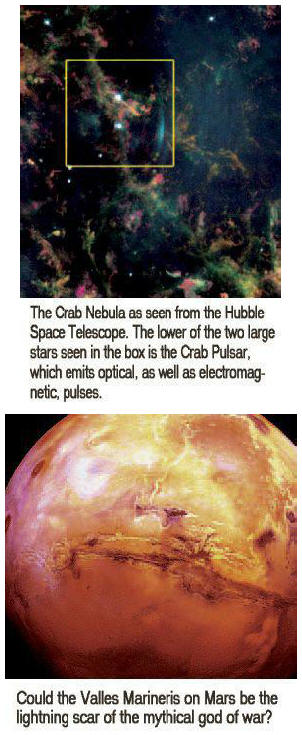
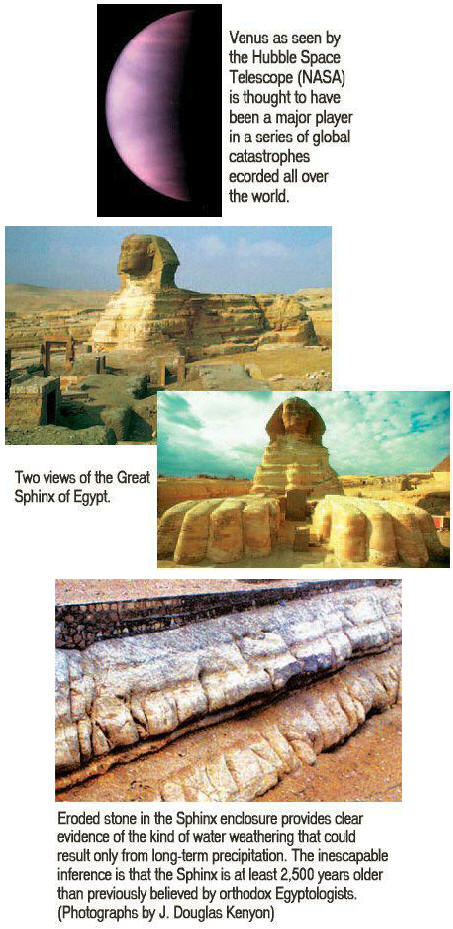
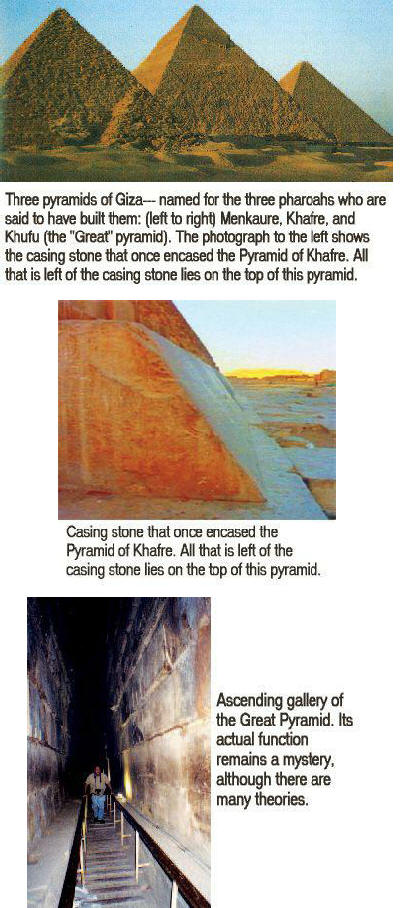
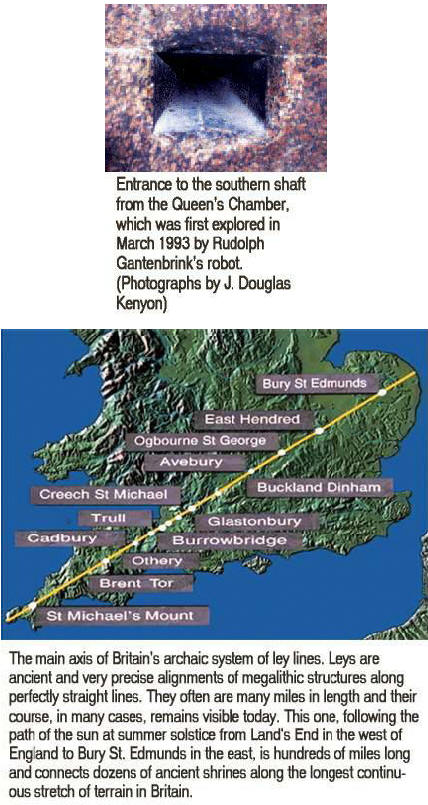
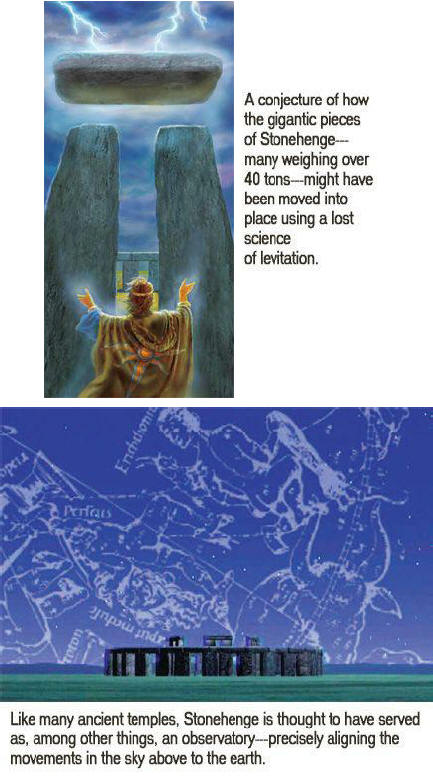
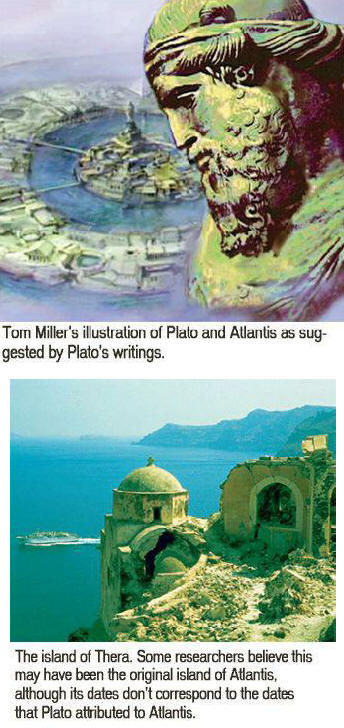
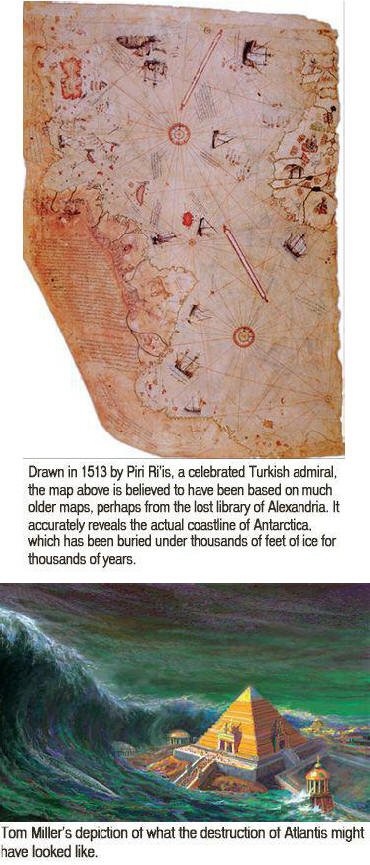
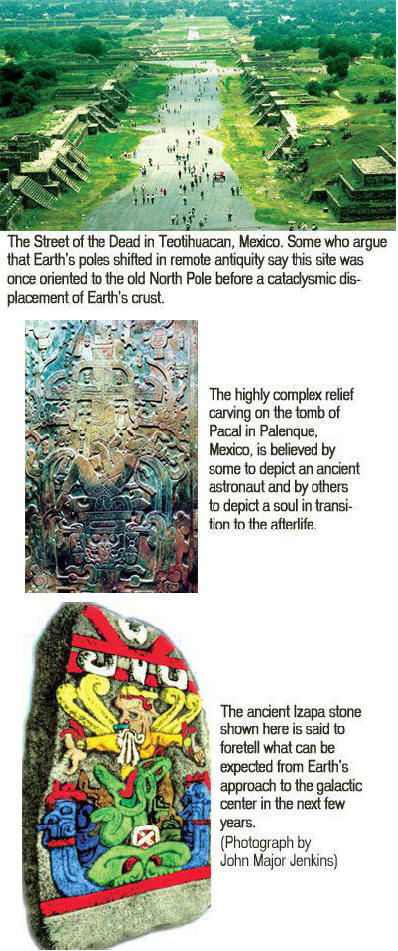
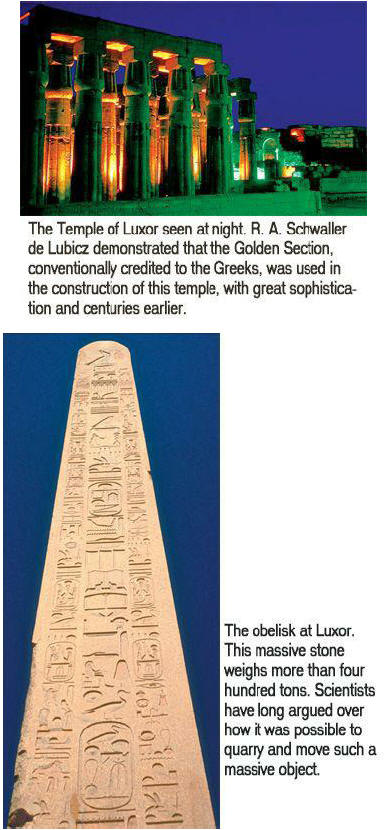
Return to The Sphinx at
Giza
13 - R.A. Schwaller de Lubicz's Magnum Opus
The Keys to Understanding the Wisdom of the Ancients Have Been
Preserved
Joseph Ray, Ph.D.
From time to time, significant events occur unbeknownst to virtually
everyone.
Great discoveries,
formidable inventions, and even profound legacies have been
delivered to humanity in relative obscurity and sometimes against
its unconscious collective will.
Such an event occurred in late 1998
with the publication of R.A. Schwaller de Lubicz's greatest work,
The Temple of Man.
The Temple of Man is an accomplishment of truly Herculean
proportions. Nothing written in the past two hundred years, with the
exception of only one book, even approaches it in enormity of
purpose, scope, subject matter, majesty, and profundity. It is also
physically enormous, as well as beautiful, and to read it properly
is a year's commitment.
To comprehend it and finally to understand
it may require additional years of effort, rereading, pondering,
and, most significantly, revelation.
One needs to learn to read this book and then immerse oneself in it.
Were one to do this, and assuming diligence, sincerity,
determination, and some ingenuity by the reader, the outcome toward
which all human life is aimed, the evolution of consciousness, is
ensured.
"Consciousness cannot evolve unconsciously," said
G.I. Gurdjieff.
His great work,
Beelzebub's Tales to His Grandson,
conveys much of the occult and profound teachings set forth in The
Temple of Man, requires similar effort, and can exert a similar
effect upon the reader.
Essential in both is the reader's open-mindedness and state of
receptivity, produced by consciously suspending mental reactions
until the teachers (the ancient sages whose mode of thought is being
transmitted) have completed their work and the transcribers of this
knowledge, the authors, have exhausted their understanding.
Every man who attempts to fathom the profound expresses himself
about it uniquely. This includes his turns of phrase, the ordering
of his thoughts, and the very manner in which he thinks (by hops,
leaps and bounds, one rung at a time, or in a direct line). To
become his student, which is to say to place oneself in a state of
maximum sensitivity to the ideas he expresses, one must familiarize
oneself with his turns of phrase and mode of expression.
To the
extent that one becomes able to think, reason, and ponder in a
fashion similar to one's teacher, a psychological fusion can occur.
This fusion, by a sort of inner "resonance" in the reader-student,
metaphorically speaking shakes loose the embedded knowledge from its
innate repository, the "Intelligence of the Heart" and a fresh
understanding emerges.
The more subtle, oblique, and ineffable knowledge is, the less
suited is the cerebral intelligence to it and the more it will react
against it.
"Knowledge (or even elements of the knowledge) cannot be
conveyed through writing alone; the symbolism of the image is
indispensable," Schwaller de Lubicz says.
The "symbolique," then, is
"the concrete image of a synthesis that cannot be expressed in time..." and it is these images that evoke the synthesis.
It may sound
awkward, but the process is straightforward. True symbols appeal to
the Intelligence of the Heart, where they draw knowledge from it.
Ordinary language and the thought expressed in it, the currencies of
cerebral intelligence, are ill suited to this knowledge and always
distort it.
However, not only the pharaonic mode of thought but its mode of
perception, as well, differed from our own. We are, says Schwaller
de Lubicz, the victims of our own "mechanistic mentality" and as
such suffer from a materialistic misunderstanding of nature.
(It is
worth noting that, ever since Schwaller de Lubicz's time,
materialism has further extended its grip on human thought. Today,
despite inaccuracy and verbal inefficiency, practically everything
is described in terms of "amount" - e.g., a "fair amount" of:
knowledge, accuracy, time, skill, speed, and/or any psychological
resource. Not everything is quantity or volume!)
To become adept in the pharaonic mode requires effort, suffering,
and experiment. Two shorter works by Schwaller de Lubicz, Nature
Word and The Temple in Man, are desirable precursors to The Temple
of Man, either new or in rereading. Casual readers need not be
deterred either, for they may discover themselves being hooked by
the beauty, interconnectedness, and depth of these extraordinary
teachings of the ancient sages.
This knowledge is for those willing
to struggle, and Schwaller de Lubicz warns against concluding,
"that
the ancients meant to say something that we understand; rather one
should try to find out why they expressed themselves thus."
The Temple of Man is not a straightforward presentation of ancient
teachings. Nor is it Schwaller de Lubicz's own path, recounted in
somewhat objectified form but based upon his personal discoveries
and illuminations.
It is both and much more.
Schwaller de Lubicz
assimilated what the ancients taught: He allowed himself to be
affected (impacted emotionally) by the symbolic language transcribed
into the Temple of Luxor.
This language transcends ordinary
language, is vital and not dead, and thus is the only means of
transmitting the ineffable to future humanity free of distortion.
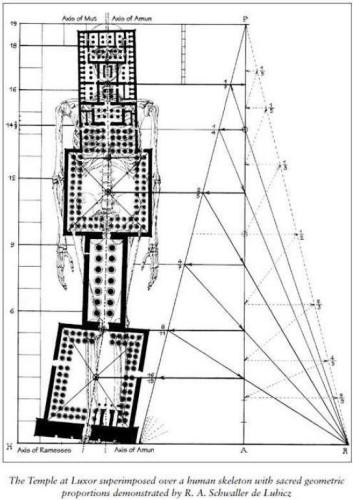
The Temple of Luxor is a pedagogical device. built to embody and
encode knowledge through the use of a variety of subtle cues (e.g..
the representation of an incorrect anatomical detail such as two
left hands. a missing detail present on the other side of a wall).
Painstakingly. the ancients integrated occult knowledge into visual.
auditory. conceptual. and architectural symbolic expressions. In so
doing. they specifically intended to bypass cerebral intelligence.
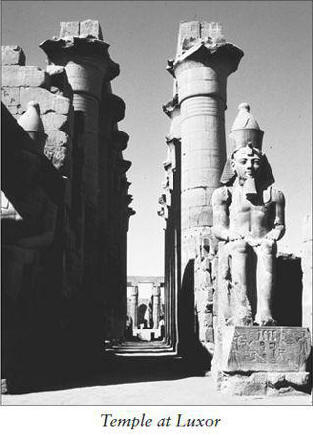
Their goal was to evoke from the student the sublime. evanescent
knowledge they knew to be embedded in the student's Intelligence of
the Heart. This true education. involving experience. emotional
impact. and work (action). causes the student to become the
knowledge. as opposed to remembering something.
As Gurdjieff said,
"A man is what he knows."
True education is an end in itself. yet is also a means of
consciousness evolution. for it incorporates its own form of
suffering.
The Temple of Man can teach the reader by means of Schwaller de Lubicz's experience rendered as his understanding. Our
experience will be less rich. but understanding can develop because
the ideas themselves vivify.
How will the "scholars" within the Egyptological establishment react
to this seminal work? A handful may peruse it; many will avoid
(i.e.. feign ignorance of) The Temple of Man.
Some may describe the
work as a concoction of Schwaller de Lubicz's fertile imagination.
In this regard, it needs to be stated:
No mere mortal ever, in
history or in the future, could have an intelligence so vast, an
imagination so fecund, and an integrative capacity so complete as to
have made up, somehow or other, the contents of The Temple of Man.
It proves itself in its very unimaginability. Moreover. many of the
teachings and unifying conceptions in it can be found in sources
entirely independent of ancient Egyptian thought. Consider the
"science of correspondences" - knowledge that underlies the
ancients' selection of symbols.
Swedenborg. who lived during the eighteenth century and never
visited Egypt. wrote at length on the subject of "correspondences."
and it became the title of one of his books.
A section of Heaven and
Hell is devoted to the subject.
"The most ancient people. who were
celestial men. thought from correspondence itself. as the angels
do"; "The whole natural world corresponds to the spiritual world..."; "the knowledge of correspondences is now wholly lost."
Indeed, the seminal Anthropocosmic principle, upon which
correspondence depends and that underlies pharaonic teaching, is
considered extensively by Swedenborg, who described the universe as
"The Grand Man" and humanity as this in miniature.
Schwaller de
Lubicz uses the phrase "Colossus of the Universe" as he confirms and
amplifies all that Swedenborg told us in 1758.
The Temple of Man is organized into six parts. It contains
forty-four chapters and is presented in two large volumes. Chapter
27 onward concerns the particular architecture of the Temple of
Luxor: These chapters contain 101 plates and about a third of the
book's three hundred figures.
These latter chapters include commentaries on the plates and their
subject matter. Occasionally, the style of presentation varies, as
required by the topic. The earlier chapters form a basis for many of
the later discussions. Some are difficult and some possibly are of
lesser interest. When I felt that rereading a chapter would
facilitate the growth of my understanding of it, I did so
immediately.
One must not be deterred by an apparent opacity of the
text and the ideas therein that may be beyond present comprehension:
Mental alchemy can and will occur.
Schwaller de Lubicz warns that "effort" is required. This effort is
a form of suffering. And the ancient sages stated clearly that
suffering is the engine for the evolution of consciousness:
"It is
suffering that causes the widening of consciousness," where
suffering "is understood as a profound experience brought about by
the conflict of consciousness, not as sorrow."
Acquiring just some
of the pharaonic mentality is suffering itself as the modern,
"mechanistic mentality presents a formidable barrier," in Schwaller
de Lubicz's words.
He describes the nature of cerebral intelligence,
ordinary thought, as constrictive and "centripetal."
Indeed, most of us live within the cage of ordinary consciousness
established and maintained by the cerebral intelligence. Conversely,
pharaonic mentality, the "noncerebral" Intelligence of the Heart, is
expansive, synthetic (as opposed to analytic), intuitive,
noncomparative, direct, and innate, and thus evoked. Getting there
is one's personal death and life story: Suffer gladly.
Schwaller de Lubicz wrote The Temple of Man,
"...first to show the
means of expression used by the ancients to transmit knowledge," and
"...second, to present an outline of the doctrine of the Anthropocosmos, the guide to the way of thinking of the sages."
To
fulfill this goal required the consideration and discussion of
subjects seldom seen in occult, esoteric, or spiritual writings: Anthropocosmos, Pharaonic Calculation, Cosmic Principle of Volume,
The Covered Temple, The Head, Crossing, The Knees, Receiving and
Giving are examples.
One must acquire a good feeling for Elements, Consciousness, and
Irreducible Magnitudes, as well as Symbolique, to begin to fully
appreciate all of these latter chapters.
This may take some time.
As
mentioned, however, even casual readers - that is, non-students -
will find wise statements everywhere, conjectures verified now by
time (this book is more than forty years old), and remarkable
insights: The pages contain much spiritual food, some of which may
be ingested raw.
"The Anthropocosmic doctrine [holds that] each plant and animal
species represents a stage in the evolution of consciousness..."
Man is a microcosm of the macrocosm.
"Thus the Universe is incarnate
in man and is nothing but potential Man, Anthropocosmos."
In this
system, creation and generation are central; the forces of genesis
and the moment of expansion are the subject matter.
Humanity, by the way, procreates but creates nothing. In applauding
our pseudo-understanding of life because we genetically engineer a
plant, clone a sheep, or grow a human pinna (ear) on a mouse's back,
we succumb to pride and self-delusion, our great foibles.
Were modern humanity not so disordered in life, out of touch with
nature, and imbalanced as well, gaining pharaonic insights would
still be difficult. But we have developed the "cult of convenience"
to a high order and live by another modern principle, that of
"something for nothing."
Inasmuch as, in the spiritual realm,
payment is a principle, such a worldview further amplifies the
impediments toward pharaonic mentality.
Those who have seen, generally, the hollowness of modern thought
must be at pains to discover its effects in themselves, so invidious
is its process.
The need to be surrounded by people, sound,
activity, even noise, arises in the psychological consciousness of
the cerebral intelligence, which subsists on stimulation. Says Schwaller de Lubicz, most modern people (as of the 1950s) could not
have "stood" the serenity that prevailed in ancient Egypt.
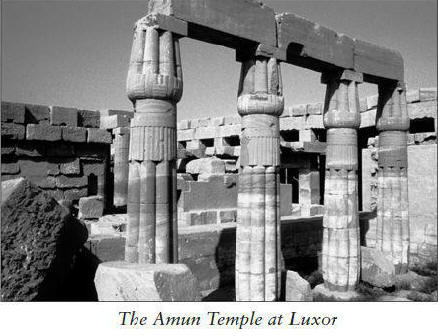
Schwaller de Lubicz tells us that, in order to grasp the essence of
the Anthropocosmic teaching, we need to reestablish in our minds a
proper notion of the term symbol.
A symbol is not merely "any letter
or image that is substituted for the development of an idea."
Instead, a symbol is "a summarizing representation, which is
commonly called a synthesis." This process "feels" like something,
often exhilaration.
The ancients selected these symbols knowing virtually everything
about the natural counterpart (the correspondent) from gestation to
its death.
Mental caution is necessary, however, and the tendency to
"fix," by definition, the essence of the symbolic representation
must be avoided. The qualities of a symbol are many and varied and
not to be linguistically rigidified any more than molten lava.
The
symbol is alive, vital, and dynamic, because Anthropocosmic doctrine
is a vitalist philosophy.
"To explain the Symbol is to kill it..." and, indeed, the
landscape of academic Egyptology is everywhere strewn with the
carcasses of dead, unheard symbols. "Rational thinkers" believe
we've passed beyond simplistic thinking.
Rather, in the last two
millennia, we have fallen into it.
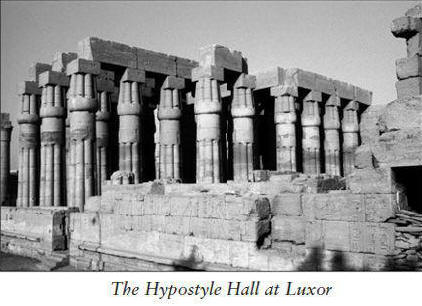
Many concepts of modern thought are defined and understood
differently in The Temple of Man - so many, in fact, that
scientists, academics, and people generally, having unconsciously
espoused a mechanical rationalism, will be forced to reject these
ideas out of hand.
"Cause and effect are not separated by any time."
There exists a,
"principle of the (present moment), mystical in
character, that modern science ignores," says Schwaller de Lubicz.
These and other similar statements cannot be reconciled with the
current and opposing worldview.
But one may examine the modern
socio-scientific-technological state of the world in light of these
ideas and, from so doing, draw tentative conclusions concerning the
relative merit of the ancients' teachings.
The history of science demonstrates that we seldom build upon the
great discoveries of preceding generations of scientists.
Few
physicists today know Kepler's laws of planetary motion; even fewer
mathematicians appreciate that his unconventional use of the
fractional notation of powers (e.g., X2/3 power) and the unique
position he accorded the number 5 (which led to this) were a part of
pharaonic mathematics thousands of years earlier.
Modern science is
as "pouring from the empty into the void," to quote Gurdjieff.
Modern science, Schwaller de Lubicz says, is founded upon incorrect
premises. We know kinetic energy, not vital energy, and we tamper
with forces, powers, and processes we do not and cannot now
understand: We are the Sorcerer's Apprentice.
Cerebral intelligence is based upon the sensory information conveyed
to it by the major sensory systems. These are understood by the
ancients in terms of both their natural, exoteric function (to
provide the brain with information) and their esoteric, spiritual
function. One cannot but be amazed, again, at the subtlety of the
insights they conveyed.
For example,
"the faculty of discernment,
located in the olfactory bulb, is the seat of judgment in man..."
Well, the olfactory bulb is a so-called primitive structure of the
brain with no direct connections to the cortex, the "advanced" gray
matter.
Nevertheless, apparently in deference to its unique
anatomical characteristics, the ancients accorded olfaction one of
the three secret sanctuaries in the head of the Luxor temple, Room
V.
The moral sense, sexuality, and the physiological distribution of
vital energy are combined in the relevant symbol, the cobra. Here in
Room V of the temple is located "conscience." Goodness has a
spiritual fragrance (a fact noted by Swedenborg. who mentioned that
the ancient Egyptians were the last to fully understand the science
of correspondences).
Subtlety is all the more difficult to acknowledge and recognize when
what is taught conflicts diametrically with what people already
believe. Ironically. we seldom have evidence that appears to
contradict the ancients' teachings. which typically go beyond our
accepted facts.
Schwaller de Lubicz includes a lengthy discussion of the Edwin Smith
Surgical Papyrus. This papyrus (from Luxor in 1862) was translated
after 1920 by the renowned Egyptologist J.H. Breasted.
The effort
convinced him of the elevated status of ancient Egyptian science and
mathematics (as it did others) but apparently modern Egyptologists
remain uninfluenced by his writing. An extensive anatomical
dictionary of the skull. head. and throat (also in hieroglyphics)
enables the reader to comprehend the many cases of head injury
described in the papyrus.
Despite the ancients' lack of a really
good source of head injury cases (e.g.. automobile accidents). their
knowledge of clinical neuroanatomy was detailed and correct. without
the benefit of EEGs. CAT scans. and magnetic resonance imaging.
The ancients described a human as comprising three interdependent
beings. each having its own body and organs. Of course. all were
essential and important. However. the head was especially so. for it
was the seat of the spiritual being. There. the blood was
spiritualized. infused with vital energy prior to coursing through
the corporeal and sexual bodies.
These bodies. vivified by the
spiritual being. live a lifetime without knowing it in a state of
ignorance or self-delusion.
Modern humanity has struck an iceberg of its own making. Those
forces we have tampered with and let loose. but which we do not
understand. threaten our annihilation. We have a role in cosmic
metabolism but are unable to fulfill it. We must cease fiddling
while our planet burns. cease occupying ourselves with liposuction.
with killing birds to kill insects. with poisoning the soil to kill
weeds. with polluting air and water.
Any sane person can see our way
of "life" has become unnatural. a condition the ancients foresaw.
Everyone's consciousness needs to expand. to evolve: We need to
become aware of a great deal that. right now. escapes us. This can
occur by choice - the price is some suffering. "And now that
the temple of Luxor has shown us the way to follow. let us begin to
explore the deeper meaning of the teaching of the pharaonic sages."
wrote Schwaller de Lubicz. We shall discover along the way what a
trivial price we are asked to pay.
Back to Egypt - The Land of Kem
14 - Fingerprinting the Gods
A Bestselling Author Is Making a Convincing Case for a Great but
Officially Forgotten Civilization
J. Douglas Kenyon
Although few people would question the popularity of the movie
Raiders of the Lost Ark, no academic
worth his salt ever dared to say the movie was more than a Hollywood
fantasy. either.
So when the respected British author Graham Hancock
announced to the world in 1992 that he had actually tracked the
legendary Ark of the Covenant of Old Testament fame to a modern-day
resting place in Ethiopia. serious eyebrows everywhere twitched
upward. Nevertheless. objective readers of his monumental volume The
Sign and the Seal on both sides of the Atlantic soon realized that
Hancock's case. incredible though it seemed. was not to be easily
dismissed.
The exhaustively researched work went on to enjoy
widespread critical acclaim and to become a best seller in both
America and the United Kingdom as well as the subject of several
television specials.
Hancock's writing and journalistic skills had been honed during
stints as a war correspondent in Africa for The Economist and The
London Sunday Times. Winner of an honorable mention for the H. L.
Mencken Award ( The Lords of Poverty, 1990). he also authored
African Ark: Peoples of the Horn, and Ethiopia: The Challenge of
Hunger. In The Sign and the Seal.
Hancock was credited by The
Guardian with having,
"invented a new genre - an intellectual
whodunit by a do-it-yourself sleuth..."
Apparently, though, the success of The Sign and the Seal only
whetted the writer's appetite for establishment chagrin.
His
subsequent book,
Fingerprints of the Gods: The Evidence of Earth's
Lost Civilization, sought nothing less than to overthrow the
cherished doctrine taught in classrooms worldwide. that civilization
was born roughly five thousand years ago.
Anything earlier. we have been told. was strictly primitive. In one
of the most comprehensive efforts on the subject ever - more than
six hundred pages of meticulous research - Hancock presents
breakthrough evidence of a forgotten epoch in human history that
preceded. by thousands of years. the presently acknowledged cradles
of civilization in Egypt, Mesopotamia, and the Far East.
Moreover,
he argues, this same lost culture was not only highly advanced but
also technologically proficient. and was destroyed more than 12.000
years ago by the global cataclysm that brought the ice age to its
sudden and dramatic conclusion.
Kirkus Reviews called Fingerprints of the Gods "a fancy piece of
historical sleuthing - breathless but intriguing. and entertaining
and sturdy enough to give a long pause for thought."
Graham Hancock discussed Fingerprints of the Gods with Atlantis
Rising, wherein he indicated that the book was enjoying the kind of
favorable media attention that helped to make The Sign and the Seal
an American hit. Interviewers. Hancock felt. were generally positive
and open to his ideas.
Though the reception among academics had been
something less than cordial, that was to be expected.
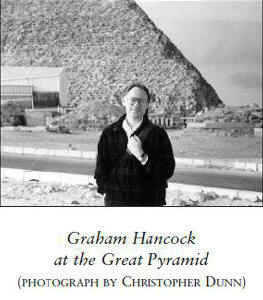
"One of the reasons the book is so long," he explained, "is that
I've really tried to document everything very thoroughly so that the
academics have to deal with the evidence rather than me as an
individual, or with what - they like to think - are rather vague,
wishy-washy ideas. I've tried to nail it all down to hard fact as
far as possible."
Nailing down the facts took Hancock on a worldwide odyssey that
included stops in Peru. Mexico, and Egypt.
Among the many intriguing
mysteries that the author was determined to investigate fully were:
-
Ancient maps showing precise knowledge of the actual coastline of
Antarctica. notwithstanding the fact that the location has been
buried under thousands of feet of ice for many millennia.
-
Stone-building technology - beyond our present capacity to
duplicate - in Central and South America. as well as Egypt.
-
Sophisticated archaeoastronomical alignments at ancient sites all
over the world.
-
Evidence of comprehensive ancient knowledge of the 25.776-year
precession of the equinoxes (unmistakably encoded into ancient
mythology and building sites. even though the phenomenon would have
taken. at a minimum. many generations of systematic observation to
detect. and which conventional scholarship tells us was not
discovered until the Greek philosopher Hipparchus in about 150 B.C.E.).
-
Water erosion of the Great Sphinx dating it to before the coming
of desert conditions to the Giza plateau (as researched by the
American scholar John Anthony West and the geologist Robert M.
Schoch. Ph.D.).
-
Evidence that the monuments of the Giza plateau were built in
alignment with the belt of Orion at circa 10.500 B.C.E. (as
demonstrated by the Belgian engineer Robert Bauval).
Unfettered as he is by the constraints under which many so-called
specialists operate, Hancock sees himself uniquely qualified to
undertake such a far-reaching study.
"One of the problems with
academics, and particularly academic historians," he says, "is they
have a very narrow focus. And as a result, they are very myopic."
Hancock is downright contemptuous of organized Egyptology, which he
places in the particularly short-sighted category.
"There's a rigid
paradigm of Egyptian history," he complains, "that seems to function
as a kind of filter on knowledge and which stops Egyptologists, as a
profession, from being even the remotest bit open to any other
possibilities at all."
In Hancock's view, Egyptologists tend to
behave like priests in a very narrow religion, dogmatically and
irrationally, if not superstitiously.
"A few hundred years ago they
would have burned people like me and John West at the stake," he
says, laughing.
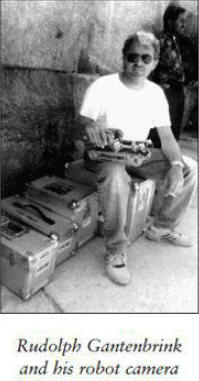
Such illogical zealotry, Hancock fears, stands in the way of the
public's right to know about what could be one of the most
significant discoveries ever made in the Great Pyramid.
In 1993, the
German inventor Rudolph Gantenbrink sent a robot with a television
camera
up a narrow shaft from the Queen's Chamber and discovered
what appeared to be a door with iron handles. That door, Hancock
suspects, might lead to the legendary Hall of Records of the ancient
Egyptians. But whatever is behind it, he feels it must be properly
investigated.
So far, though, there has been no official action, at least not a
public one.
Citing episodes personally witnessed, he protests,
"You
have Egyptologists saying 'There is no point in looking to see if
there's anything behind that slab' - they call it a slab, they won't
call it a door - 'because we know there's not another chamber inside
the Great Pyramid.'"
The attitude infuriates Hancock:
"I wonder how
they know that about this six-million-ton monument that has room for
three thousand chambers the same size as the King's Chamber. How do
they have the temerity and the nerve to suggest that there's no
point in looking?"
The tantalizing promise of that door has led Hancock to speculate
that the builders may have purposely arranged things to require
technology of ultimate explorers.
"Nobody could get in there unless
he had a certain level of technology," he says.
And he points out
that even one hundred years ago, we
didn't have the means to do it. In the last twenty years the
technology has been developed and now the shaft has been explored,
"and lo and behold, at the end is a door with handles. It's like an
invitation - an invitation to come on in and look inside when you're
ready."
Hancock is far from sanguine about official intentions:
"If that
door ever does get open, probably there will be no public access at
all to what happens."
He would like to see an international team
present, but suspects that instead,
"what we're going to get is a
narrow, elite group of Egyptologists who will strictly control
information about what happens."
In fact, he thinks it's possible
that they've even been in there already. The Queen's Chamber was
suspiciously closed for more than nine months after Gantenbrink made
his discovery.
"The story was given out that they were cleaning the graffiti off
the walls, but the graffiti were never cleaned off. I wonder what
they were doing in there for those nine months. There's what really
makes me angry, that this narrow group of scholars control knowledge
of what is, at the end of the day, the legacy of the whole of
mankind."
Gantenbrink's door is not the only beckoning portal on the Giza
plateau.
Hancock is equally interested in the chamber that John
Anthony West and Robert M. Schoch, Ph.D., in the course of
investigating the weathering of the Sphinx, detected by seismic
methods, beneath the Sphinx's paws.
Either location might prove to
be the site of the "Hall of Records." In both cases, the authorities
have resisted all efforts at further investigation.
Hancock believes the entire Giza site was constructed after the
crust of the earth had stabilized following a 30-degree crustal
displacement that destroyed most of the high civilization then
standing. According to Rand and Rose Flem-Ath's When the Sky Fell:
In Search of Atlantis, upon which Hancock relies, that displacement
had moved an entire continent from temperate zones to the South
Pole, where it was soon buried under mountains of ice.
This, he
believes, is the real story of the end of Plato's Atlantis, but the
"A" word is not mentioned until very late in his book.
"I see no
point in giving a hostile establishment a stick to beat me with," he
says. "It's purely a matter of tactics."
The Giza complex was built, Hancock speculates, as part of an effort
to remap and reorient civilization.
For that reason he believes the
10,500 B.C.E. date (demonstrated by Bauval) to be especially
important.
"The pyramids are a part of saying this is where it
stopped. That's why the perfectment, for example, to due north, of
the Great Pyramid is extremely interesting, because they obviously
would have had a new north at that time."
Despite a determination to stick with the hard evidence, Hancock is
not uncomfortable with the knowledge that his work is serving to
corroborate the claims of many intuitives and mystics.
On the
contrary, he believes that,
"the [clairvoyant ability] of human
beings is another one of those latent faculties that modern rational
science simply refuses to recognize. I think we're a much more
mysterious species than we give ourselves credit for.
Our whole
cultural conditioning is to deny those elements of intuition and
mystery in ourselves.
But all the indications are that these are, in
fact, vital faculties in human beings, and I suspect that the
civilization that was destroyed, although technologically advanced,
was much more spiritually advanced than we are today."
Such knowledge, he believes, is part of the legacy of the ancients
that we must strive to recover.
"What comes across again and again," he says, "particularly from
documents like the ancient Egyptian pyramid texts. which I see as
containing the legacy of knowledge and ideas from this lost
civilization. is a kind of science of immortality - a quest for the
immortality of the soul, a feeling that immortality may not be
guaranteed to all and everybody simply by being born.
It may be
something that has to be worked for. something that results from the
focused power of the mind."
The real purpose of the pyramids, he
suggests, may be to teach us how to achieve immortality. But before
we can understand. we must recover from the ancient amnesia.
Hancock believes we are a species with amnesia.
"I think we show all
the signs that there's a traumatic episode in our past that is so
horrible that we cannot somehow bring ourselves to recognize it.
Just as the victim suffering from amnesia as a result of some
terrible episode fears awakening memory of that trauma and tries to
avoid it. so we have done collectively."
The amnesia victim is. of
course. forced to return to the source of his pain and,
"if you wish
to move forward and continue to develop as an individual. you have
to overcome it. You have to confront it. deal with it. see it
face-to-face. realize what it means. get over it. and get on with
your life." he says. "That is what society needs to be doing."
In the institutional resistance to considering ancient achievement.
Hancock sees a subconscious pattern based on fear:
"There's a huge
impulse to deny all of this. because suddenly all the foundations
get knocked out from under you and you find yourself swimming
loosely in space without any points of reference anymore."
The
process needn't be so threatening. though.
"If we can go through
that difficult experience and come out on the other side." he says.
"I think we'll all emerge better from it. I'm more and more
convinced that the reason we are so messed up and confused and
totally disturbed as a species at the end of the twentieth century
is because of this - because we've forgotten our past."
If it is true that those who cannot learn from history are doomed to
repeat it. then there are lessons in our past that can be ignored
only at our peril.
Clearly written into the mythology of many
societies are stories of cataclysmic destruction. Hancock cites the
work of Giorgio de Santillana, of M.I.T., an authority on the
history of science who is the coauthor, along with Hertha von
Dechend, of the book
Hamlet's Mill: An Essay Investigating the
Origins of Human Knowledge and Its Transmission through Myth, in
which the authors hypothesize that an advanced scientific knowledge
was encoded into ancient myth.
Hancock points out.
"Once you accept that mythology may have
originated with highly advanced people. then you have to start
listening to what the myths are saying."
What the myths are saying.
he believes. is that a great cataclysm struck the world and
destroyed an advanced civilization and a golden age of mankind. And
cataclysm is a recurrent feature in the life of the earth and will
return.
The messages from many ancient sources. including the Bible. point
to a recurrence of such a cataclysm in our lifetime. Notwithstanding
such views. Hancock insists he is not a prophet of doom. His point
is. he says. "We've received a legacy of extraordinary knowledge
from the past. and the time has come for us to stop dismissing it.
Rather. we must recapture that heritage and learn what we can from
it. because there is vitally important information in it."
The stakes couldn't be higher.
"I'm convinced that we're locked
today in a battle of ideas." he says.
"I think it's desperately
important that the ideas that will lead to a recovery of our memory
as a species triumph. And therefore we have to be strong. we have to
be eloquent and argue clearly and coherently. We have to see what
our opponents are going to do. how they are going to try to get at
us. and the dirty
tricks that they are going to try and play. We have to fight them on
their own ground."
15 - The Central American Mystery
What Could Explain the Failure of Mainstream Science to Unravel the
Origins of Mesoamerica's Advanced Ancient Cultures?
Will Hart
It has been twenty-three years, yet I remember the morning like it
was yesterday.
A mist shrouded the
jungle above the Temple of the Inscriptions. A series of roaring
sounds suddenly split the silence as a band of howler monkeys made
their way through the trees. It startled me. I thought the sounds
might be those of a jaguar, but the cacophony added to the sense of
mystery.
My head was exploding. By the time I had reached Palenque, we had
already visited dozens of archeological sites, from the northernmost
part of Mexico down to the Yucatan Peninsula and Quintana Roo. I was
steeped in questions and mysteries.
Several things had become clear
to me: The cultures that built the pyramids and other buildings had
been advanced in the arts and sciences. I had seen many beautiful
things, as well as mind-tugging enigmas.
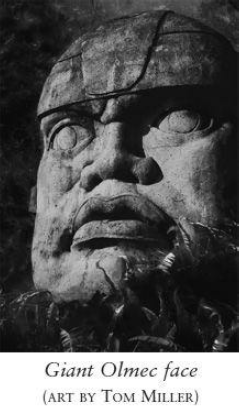
The Olmec civilization surprised me the most.
I had read about the
Maya and knew of the Aztecs, but I was unprepared for what I found
in Villahermosa: large stone heads with Negroid features and stone stelae carved with depictions of curious ambassadors. The figures
clearly were not from any Mexican culture.
These artifacts were more than just a fascinating puzzle; they
represented a headache for science. They were an anomaly. Who had
carved the heads? Who had created the stelae? Where did they get the
models for these heads and figures? These were questions that arose
because of the way scientists have reconstructed the human history
of Mesoamerica. Africans don't fit, nor do the cloaked Caucasian
figures carved on the stelae.
They shouldn't be there; however, they
are surely there.
Scientists do not claim to have solved this enigma. Anthropologists
and archeologists admit they do
not know much of anything about Olmec culture. Thus. we don't know
the ethnic group or the language and we know nothing of the Olmecs'
social organization. beliefs. or traditions. No one has any idea why
they carved the helmeted heads and then buried them. It doesn't make
a lot of sense. We don't usually bury monuments (if that is what
they are).
The only records we have are the monuments they left behind. which
are impressive. But how do we understand them? Where do they fit
into the mosaic of human history? There are no direct clues in
Mexico. The Olmecs didn't leave us any written records. However. we
do have a clue.
The Bible is an extremely important document. It doesn't matter
whether or not you are a believer. It contains a very ancient
accounting of human history compiled from a variety of early
sources. At least. this is true of the Book of Genesis. But it is
not always easy to decode.
Do we find any reference in the Bible
that might help us solve the Olmec enigma?
Turning to Genesis. chapter 11. we read:
"Now the whole Earth used
the same language and the same words."
This indicates that there was
a period in man's history when a global human civilization existed.
We learn that during that epoch. men wanted to build a tower:
"Come.
let us build for ourselves a city. and a tower whose top will reach
into heaven; and let us make for ourselves a name; lest we be
scattered abroad over the face of the whole Earth."
The fact that the Olmec civilization presents science with an
anomaly indicates something quite profound: The data does not fit
the current model.
Scientists can't change the observable data; it
is as hard as data can get. But they could change the model to
conform to the data. There is the rub. Anthropologists and
archeologists have a huge investment in that model. an intellectual
edifice that has been built up over generations.
Scientists would rather ignore the tough questions and leave the
Olmecs alone in the dim mists of forgotten antiquity. That is not a
very scientific approach. Where is the pursuit of truth? What
happened to the scientific method? It is just not acceptable. Why?
Some ancient society built the huge mound. dragged the basalt heads
about sixty miles from the quarry to the burial site (those heads
weighed from five to twenty-five tons). and carved the figures into
the stelae. They wouldn't have gone to all that trouble unless the
people the monuments represented were important to them. This is a
logical assumption to make and we can only hope that scientists in
the distant future will reach the same conclusion when they study
Mount Rushmore.
Since we have the artifacts. we know that there has to be an
explanation for who the builders were. As with any other mystery.
you search for clues. You begin in the most likely places and work
your way down the list: Mexico.
The problem is that the Olmecs
disappeared from the scene long before Cortez arrived. None of the
cultures contemporary with the Aztecs made any references to the
Olmecs; they seemed to know nothing about them. And no other Negroid
heads have been found in Mesoamerica. Another curious fact is that
the developmental period that must have preceded the mound building
and head carving is nowhere in evidence.
The Olmecs just suddenly appeared. then disappeared!
It took me years of investigation to finally realize that the most
probable answer was in the Bible. and ironically. the Bible was just
about the last place I had thought to look.
Did the Olmecs come from
outer space. as some researchers have proposed? Not necessarily. For
one thing. there is no evidence to support this theory. Second. the
Negroid heads and the people depicted on the stelae are obviously
human.
The idea that there was a global civilization in ancient times does
not conform to the current model of science. However. it is
corroborated by the reference in the Bible. The problem with the
scientific model is that it can't explain the available data. and
that is a serious issue that has many consequences. If the problem
was limited to the Olmec civilization. we might just let it go.
But
there are artifacts in Egypt. South America. and other parts of
Mexico that also don't fit the orthodox scheme.
Scientists have often shown a willful blindness regarding artifacts
and developments that they can't explain using their belief system.
Worse. they have either ignored key questions or discredited the
facts. Many other hard facts. the remains of lost civilizations. and
the cultural records of numerous peoples corroborate the Olmec
enigma and the Bible.
References to a cataclysmic flood occur in 230 different cultures.
Mayan history includes the story of how the Maya came from a land to
the east that had been destroyed. Herodotus's History recounted of
the tale of lost Atlantis. Accounts such as these may sound like
romantic myths spun out of early imaginations; however. when you
stand at an ancient site surrounded by strange ruins... you begin
to wonder if they just might contain more than a grain of truth.
I climbed the steps of the Temple of Inscriptions and visited the
tomb of Pacal. Then I decided to take a long trip down to the Rio
Usamacinta. to Bonampak and Yaxchilan. It was one hundred miles of
bad dirt road. heavily rutted in places. It finally became so muddy
that we mired the van up to the axles. We had nearly reached the
destination; Bonampak was a short walk. I visited Bonampak.
My next destination was Yaxchilan, a ruin secreted in the jungle
about eight miles from Bonampak. I decided to try and hack my way
there with a machete, against the advice of the natives, who had
warned me: "La selva está cerrada!"
They were right. I gave up after
a grueling four-hour stint in which I traveled less than a quarter
of a mile. spent mostly on my belly trying to avoid razor-sharp
thorn shrubs. The insects were ravaging my body.
Yaxchilan is situated on the river and is alleged to have been the
center of the flourishing Mayan civilization in this region.
In
February 1989, James O'Kon did manage to make it to this site, one
that archeologists had been studying for a century.
A particular
mound of rocks caught O'Kon's trained eye. Scientists had dismissed
it as a minor mystery but the amateur archeologist was also a
forensic engineer, and he immediately knew what this mound really
was: part of a bridge.
He turned to modern technology to help prove a bridge had once
existed at the site. O'Kon, a former chairman of the forensic
council of the American Society of Civil Engineers. had used similar
techniques during routine investigations.
He compiled field
information at the Mayan site and used computers to integrate
archeological studies, aerial photos, and maps; to develop a
three-dimensional model of the site; and to determine the exact
positioning and dimensions of the bridge.
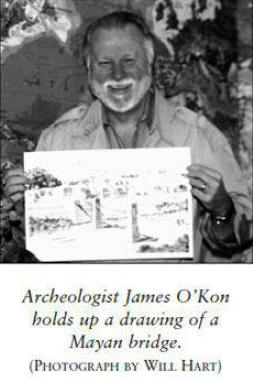
O'Kon ended up making a startling discovery: The Maya had
constructed the longest bridge span in the ancient world.
When he
finished his calculations and computer models, the bridge turned out
to be a six-hundred-foot (200 meters) span, a hemp-rope suspension structure with
two piers and three spans. It connected Yaxchilan, in Mexico, with
its agricultural domain in the Petén (now Guatemala), where Tikal is
situated.
What archeologists had assumed was an insignificant rock pile turned
out to be part of a crucial finding:
a pier twelve feet high and
thirty-five feet in diameter.
Aerial photos located a second support
pier on the opposite side of the river. Both piers were constructed
of cast-in-place concrete with an exterior of stone masonry, which
is exactly how the Mayan pyramids were made.
In interviews O'Kon, who has been studying the ancient Maya for
thirty years, said,
"The Maya were very sophisticated mathematically
and scientifically."
He claimed that the design requirements of the
Mayan bridge paralleled twentieth-century bridge-design criteria.
Today we marvel at the ruins and speculate on how and why the Maya
built the ceremonial sites. We shouldn't forget that they were an
advanced race. They understood astronomy. They had an accurate
calendar. They understood the concept of "zero" at least seven
hundred years before the Europeans did. The Maya built paved roads
and, as we have now learned, the longest suspension bridge in the
ancient world.
What occurred to me while standing atop another pyramid, at Coba in
Quintana Roo, surveying a trackless jungle was the fact that the
Maya had achieved all this in a jungle. No other advanced
civilization I could think of had emerged from a jungle environment.
It deepens the mystery of this lost race.
The sacbe are a system of roads that interconnect the sites. This is
another feature that has long puzzled scientists and independent
investigators alike. The roads were built up with rocks, leveled,
and paved over with limestone cement. They vary in width from eight
feet to thirty feet.
The mystery is simple: Why would a "Stone Age"
people without wheeled vehicles or dray animals need such an
elaborate and sophisticated road network?
O'Kon turned his attention to the sacbe after finishing his work on
the bridge and discussed the fact that he had found the sixty-mile
road that extended from Coba to Yaxuna to be as straight as an arrow
with a negligible deviation.
His studies have revealed the Maya were
not Stone Age (he refers to them as "technolithic"). They didn't use
iron. because the nearest mines were 1.500 miles away. O'Kon claims.
"They used jade tools and they were harder than steel."
You almost have to stand at a site and imagine the scene as it was
during the peak of Mayan civilization to really grasp the magnitude
and appreciate what this culture achieved.
Today we see ruins and
jungle and pyramids that are little more than bare stone. crumbling
buildings surrounded by wilderness. However. in that day. the
pyramids were coated with stucco. They were smooth and they gleamed
in the sun. The walls of the structures were painted in various
designs of bright colors. The courtyards were paved.
The flat white
roads radiated out in all directions. connecting the centers.
Yet despite the Maya's advanced knowledge of astronomy and
mathematics and their achievements in art and architecture.
scientists still consider them a Stone Age culture.
Time is the essence of life. Human beings have always been immersed
in it. and have kept track of it in one way or another: measuring it
as minutes. hours. days. weeks. months. years. centuries. and
millennia.
We know of many of its dimensions and we have used them
to our advantage. We know, supposedly, how long ago dinosaurs roamed
the earth, how long it takes for various radioactive isotopes to
decay, when our early hominid ancestors branched off from apes, the
layout of the human genome, the exact dates of lunar and solar
eclipses long into the future.
Time causes all living things to grow old and die. It seems so
obvious and ubiquitous, we are like fish and time is water. We never
ask the basic questions: What is time? Do we understand it? Is it
more than a system of measurement, whether of the present moment or
of the age of the universe?
All cultures certainly have a focus on time; however. the Maya had
an obsession with it. They tracked and measured the synodic period
of Venus. which is 584 Earth days. The 365-day Mayan calendar year
was more precise than the Gregorian calendar. They devised three
different calendrical systems: the tzolkin (sacred calendar). the
haab (civil calendar). and the long count.
The tzolkin is a cycle of 260 days (thirteen months of twenty days
each) and the haab is the solar cycle. These two calendars were
combined in an interlocking fashion to produce a cycle of 18.980
days. which was known as a calendar round. about fifty-two years.
Each day had a particular glyph and meaning ascribed to it. and at
the end of the fifty-two-year cycle a renewal ceremony would be
performed. The long count period lasted for about five thousand
years. This was equivalent to an age.
According to the Maya.
humanity is in the fifth "Sun" or "Age." That will end about five
thousand years from the beginning of their calendar. which started
in 3011 B.C.E. and expires in 2012.
The longest cycle in Mayan cosmology is 26.000 years. which
corresponds to the precession of the equinox. Why did the Maya have
such a fascination with astronomy? Why did they create such an
intricate calendrical system? Would a Stone Age agrarian society
need all this advanced astronomical and mathematical knowledge? How
did they acquire it in such a short time?
How would they have had
any
awareness of such a complex phenomenon as the synodic length of
Venus or the precession of the equinoxes?
The Maya are either more ancient than science allows or they had
more sophisticated technology than we know of. Perhaps someone
passed down this knowledge to them? Is it coincidental that the
beginning of the fifth Age was 3000 B.C.E.. which corresponds to the
birth of the Jewish and Chinese calendars? The assertion that the
"world" is only five thousand years old may have more truth to it
than we know. Is it also a coincidence that so many Christians
believe we are now in the end of times?
The Mayan obsession with time may have been based on a deep
awareness of how it functions on a cosmic scale and then unfolds on
Earth in short-and long-term cycles.
That may be the message that
the lost civilizations have been trying to deliver to us, and we may
just be starting to get it.
16 - Destination Galactic Center
John Major Jenkins Thinks Today's World Has Much to Learn from the
Ancient Maya
Moira Timms
Ancient Mayan trumpets erupt in a wash of primal, shamanic sound.
The huge dome of the planetarium, like some fish-eye lens, glows
with myriad pre-dawn stars. As the sun rises and breaks through the
artificial horizon to everyone's left, the ancient music fades, and
the crack between the worlds is open once more.
In his calm, focused
way, the researcher and author John Major Jenkins begins his
presentation and delivers the goods: According to ancient Mayan
cosmology, we live today in a time of rare galactic alignment, when
our solar systems with the heart of our galaxy, the galactic center.
Our age is a time of transformation fixed by the Mayan calendar's
end date on
December 21, 2012.
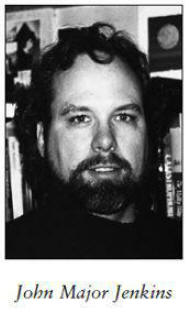
Jenkins, an internationally recognized expert on ancient astronomy
and the Mayan calendar, recently spoke of his work and life.
"I am
devoted to reconstructing lost cosmologies," he says, "to unraveling
the knotted threads of a vast, global paradigm now forgotten."
He
emphasizes that his work is both an explication and a celebration of
the Primordial Tradition, or perennial philosophy - terms that refer
to the universal truths at the core of the world's major religions
and philosophies that have endured down the ages.
"I believe the human race can grow spiritually by reviving the
ancient Primordial Tradition that has become buried beneath the
materialism of the modern world," he says.
And it is Jenkins's
discerning and painstaking retro-sleuthing into that tradition that
has penetrated the rich substrata beneath the materialism of our
time and discovered ancient hidden "treasure" - namely, the galactic
alignment not only at the core of the Mayan calendar, but also at
the center of Vedic cosmology and various Old World traditions,
including Mithraism, sacred architecture, and Greek sacred
geography.
He lays out the details of his progressive reconstruction
in two groundbreaking books:
-
Maya Cosmogenesis 2012: The True
Meaning of the Maya Calendar End Date
-
Galactic Alignment: The
Transformation of Consciousness According to Mayan,
Egyptian, and Vedic Traditions
In the mid-1990s, while researching the 2012 end date of the Mayan
calendar, Jenkins decoded what he calls the "galactic cosmology" of
the Maya.
He realized that the ancient Maya understood the
26,000-year cycle known as the precession of the equinoxes and the
earth's changing orientation to the galactic center.
For the ancient
Maya, tuning in to this stellar shifting inevitably led to the
realization that at some point in the far future, the December
solstice sun would with the Milky Way's center, which can be seen as
a "nuclear bulge" between the constellations of Sagittarius and
Scorpio. The Maya thought of the Galactic Center as the
ever-renewing womb of the Great Mother, and targeted the alignment
with the end date of their calendar.
Jenkins's approach is to skillfully cross-pollinate the discoveries
of archaeoastronomy. iconography. and ethnography. blending them
into a profoundly coherent synthesis.
This has enabled him to revive
a fragmented worldview that he calls "multidimensional."
He is
interested not in inventing a new system. but in reviving the old
one. one that because of its galactic focus is advanced in ways that
modern science can barely appreciate. By accessing the myths.
symbols. texts. and voices of the Primordial Tradition.
Jenkins says
that,
"it is clear that the Primordial Tradition is galactic in
nature - the Galactic Center is its orientational locus and is the
transcendental source of the wisdom it encodes. which now appears
ready to make a dramatic appearance on the stage of human history... like a lost Atlantean dimension of the human soul."
Because the astronomical mapping laid out in Jenkins's recent books
plugs so meaningfully into the sockets of the alignments and
geodetics of so many sacred sites. the esoteric Hermetic dictum of
"As above. so below" is now revealed fact.
This is particularly true
at Izapa in Chiapas. Mexico.
"This is the site that gives us the
2012 calendar." says Jenkins. "Here, the Mayan wisdom about what the
2012 alignment means for us is encoded into the monumental
sculpture!"
Three ceremonial monument groups at Izapa contain the "legacy" to
our time in terms of understanding the galactic cosmology of the
ancient Maya.
Jenkins decodes the ball court group at Izapa as,
"ground zero of this knowledge, and there is plenty there to help us
understand what we, today, are fated to live through. The encoded
message of the ball court is a testimony to the brilliance of the
ancient Izapan skywatchers."
A VISION QUEST
Jenkins recalls that as a child he was fascinated by gadgets and
science.
"I would take things apart and - sometimes - put them
back together. Thomas Edison was my hero."
By high school, Jenkins
says, he had exhausted science as an avenue of self-knowledge and
began reading philosophy.
"And that," he says, "led to Eastern
mysticism. This opened up a Gnostic path for me. a path of inner
knowing. and I began to practice Yoga and meditation. I studied
Tibetan mysticism. practiced celibacy. and wrote devotional poetry.
I was trying to grow spiritually and free myself from the suburban
nightmare of materialism that surrounded me."
By the time Jenkins reached twenty, that which was building within
him was difficult to contain.
"An inner spiritual crisis was welling
up inside me. and I embarked on a pilgrimage that took me around the
southeast United States. My mobile hermitage was a 1969 Dodge van
that I lived in for seven months. As my pilgrimage reached a
crescendo. I meditated. chanted. and fasted. in locations along the
Gulf Coast or in Forest Service campgrounds in the Florida
panhandle."
Jenkins wrote of this period in his 1991 book. Mirror in
the Sky.
"This is the first time I have publicly shared this aspect
of my past." he says.
"The pilgrimage spontaneously culminated in a three-day vigil.
crying for a vision. chanting. and praying. It was a crisis of
connection with a higher guiding force that I yearned to serve. In
the early predawn hours on the cusp of Pisces. I had a mystical
vision of the boon-bestowing goddess Govinda, who I also call the Earth Guardian."
Jenkins says that the
experience was attended by what is called, in Yoga, a kundalini
rising.
"It wasn't 'just' a dream or vision. as it was attended by
an actual physical process called 'a turnabout in the deepest seat
of the being' or 'the backward flowing method' described in the
Taoist book The Secret of the Golden Flower."
Jenkins believes this experience with the goddess was the "boon"
that bestowed upon him his mission, that led him to the Maya, a path
that he now pursues in service to the Great Mother and the perennial
wisdom.
"It opened up a path of knowledge for me." he says. "Less
than a week after that vision. I met the person who encouraged me to
travel to Mexico and visit the Maya."
Around that time Jenkins also
read (the now classic) Mexico Mystique, by Frank Waters.
Today, almost twenty years later, Jenkins says that the connection
with that original guiding force,
"continues to actively work within
me, so I can continue to be a mouthpiece for the perennial
philosophy. But balancing that call with the demands of making a
living and paying the bills has, at times, been daunting."
THINKING AND KNOWING
Jenkins's mystical leanings are not that apparent in his recent
books. which are academically rigorous and well documented without
denying the deeper spiritual truths.
In his view.
"The intellect is
not inconsistent with spirituality. Early on in my research. when my
writings shifted from poetry and song writing to nonfiction
research.
I felt it would be critical to be clear and concise with
my findings. mainly because spiritual materialism in New Age
publishing seemed to be diluting the pristine purity of the
universal truths with which it was coming into contact.
"Metaphors drawn from the profane modern culture and new terms were
being coined for eternal truths... distortion of the ancient
wisdom was happening. So I decided to place my rational intellect in
service to the higher intellect. which is to say the heart. The
heart is really higher than the brain."
With this approach,
Jenkins's work exemplifies the ability to go beyond the astronomy
and venture more deeply into the metaphysics of spiritual
transformation that awaits us on our approach to the galactic
gateway.
The galactic gateway. and its meaning for our time, is the focus of
Galactic Alignment. As we approach the 2012 end date of the Mayan
calendar, it is clear that the knowledge expounded in many of the
world's wisdom texts regarding the end of the present world age
comes together and is solidly interpreted in Jenkins's latest book.
According to his findings, the last of the four Hindu cycles of
time, called Yugas, completes in synchrony with the Mayan end date.
as does the Age of Pisces.
Christian millenarianism. via the year 2000. is also surprisingly
close to the galactic alignment. The 2012 date itself is the
astronomically defined time when the winter solstice Suns with the
center of the Milky Way.
Jenkins surveys the work of the galactic
philosopher Oliver Reiser to offer a scientific interpretation of
how our solar system and the galactic plane become aligned, and what
possible effects might result for life and consciousness on Earth.
An inevitable question is,
"Does our changing relationship to the
greater universe mean anything?"
Jenkins's anticipation of this
question is fully developed in Galactic Alignment, but the basis for
a response to the question, he insists, is that,
"what is happening
now was the centerpiece of many, many ancient systems and ancient
philosophies, in virtually all of the world's traditions. If our own
civilization
- including our scientific and religious leaders - fails to see any
meaning in this factual event, then we stand alone, divorced from
the world's traditions that did."
Professor Jocelyn Godwin, of Colgate University. himself an author
on esoteric subjects. sees value in exploring the 26.000-year
processional cycle (of which the galactic alignment is the
"completion" event) in terms of what it means.
He says,
"John Major
Jenkins is the most global and erudite voice of a swelling chorus of
'Galactic Center' theorists. By framing the subject in the context
of the Primordial Tradition. he raises it to a new level of
seriousness. and of reassurance."
Jenkins emphasizes that his work does not promote a new "system" or
"model." but rather offers a reconstruction of lost knowledge.
And
he notes that. in retrospect. his pursuits seem to have been guided
by the initial inspiration of his original contact with the Earth
goddess of his vision. He senses that "strings have been pulled
behind the scenes" to help manifest his work. which is ultimately
about the rebirth of the world.
He says he finds the amount of
misunderstanding and misinformation that is circulating "incredibly
sad" and that. most of all. he wants his work to be an inspiration.
to help people understand more deeply ancient teachings about human
transformation.
THE BEGINNING IS NEAR, THE BEGINNING IS NEAR!
In many of the world's major cultures of antiquity. the center of
the Milky Way galaxy was conceived of as the womb of the Great
Mother goddess. the source and center of manifest worlds. and the
ultimate means of our renewal at the end of a historical "chapter."
The Galactic Center region was. to the Maya. a source point. or
birthplace.
Because of this. Jenkins's early "rebirth" experience with the
boon-bestowing goddess is especially meaningful. because it led him
so directly into the work that has been the revelation of the whole
mythic structure surrounding the 2012 astronomical time. when the
Sun will be "re-birthed" in the "womb" of the Great Mother at the
center of the Milky Way.
Jenkins believes it is especially important
to understand that 2012 indicates an alignment process and that any
expectations should not focus on one precise day.
Nevertheless. 2012 has entered popular consciousness and can be
considered the end of a Great Year of precession. a death of the old
and the birth of the new - just as with the turning of the day or
the lunar month or the solar year. Our precessional journey around
the great wheel of the zodiac is humanity's 26.000-year gestation
period. and the birth time is era-2012.
As in all beginnings. new
life is the purpose. but there is always a possibility of mishap or
disaster if all is not in harmony with the force and magnitude of
the "rite of passage" known as birth. Resistance versus acceptance
can lead to different results.
Questions naturally arise concerning what Jenkins sees on the
horizon between now and 2012. Jenkins eases his way into his
response.
"It may be unpopular to say it. but it's true." he says.
"What 2012 was intended to target is not about 2012; it is about a
process-oriented shift. It's about an open door. a once-in-a-precessional-cycle
zone of opportunity to ourselves with the galactic source of life."
He points out that there are forces already set in motion,
"propelling us through a crucible of transformation unlike anything
experienced in millennia... The sobering and humbling fact is
that we are being called to create. nurture. and help unfold
something that will not flower until long after we. as individuals.
have died. The larger life wave of humanity is at stake."
And he
reminds us of the Native American teaching to look ahead seven
generations in order to make wise decisions. and suggests this
should be our guiding
maxim as well.
As to the 2012 date itself, Galactic Alignment points the compass of
time not to a cause-and-effect event. but rather to a higher process
of spiritual transformation (which can be intense and challenging).
If the 2012 date means anything specific, it is more likely to be a
rally date for the traditional Maya, whose calendrics designated the
2012 date as the end of a World Age, a truth deeply embedded in
their creation mythology.
The Mesoamerican masterminds who wove together mythology, political
organization, religion, and astronomy into one seamless whole must
surely have wanted the modern Maya to understand and reclaim the
greatness of their people's past achievements.
In Galactic Alignment Jenkins explores how the galactic alignment is
a central doctrine in global traditions.
He finds it in Mithraism,
Vedic astronomy, the doctrine of the Yugas, Islamic astrology,
European sacred geography, Christian religious architecture of the
Middle Ages, and various Hermetic traditions.
"For me, this means
that
the galactic alignment wisdom of the Maya 2012 end date is even
at the core of Western spirituality, and can unify traditions that
on the surface seem so very different."
One wonders how Jenkins sees the core of his work, and what is next
for him.
"The core? My ongoing relationship with Sophia. the higher
wisdom. It was that vision in 1985 and my work with the Tree of Life symbology that have led me into these areas of exploration.
The
archetype of the Great Mother of renewal and wisdom is a recurring
motif that emerges in almost all of my books - even if I wasn't
intending it at the outset.
Overall, the core of the work is about
healing, renewal. and opening up a little door at the end of time
that leads into a new world, a new cycle in the drama of human
unfolding."
Back to
Contents
|





















